Issue 3.9: A Tale of Two Case Studies
What Diablo: Immortal and Animal Crossing: New Horizons Tell Us about Games' Psychological and Sociological Effects
Hello! If you enjoy Game & Word, please hit the “heart” button at the very top or very bottom of this post, or on the bottom-left corner of the Substack app. It helps more people find Game & Word, which helps us survive and grow!
NOTE: Gmail users, you might see a truncated version of this message. If this happens to you, just click the “View entire message” link next to where it says “[Message clipped]” to read the rest.
Game & Word, Volume 3, Issue 9: Sunday, Jul. 17, 2022

Publisher: Jay Rooney
Author, Graphics, Research: Jay Rooney
Logo: Jarnest Media
Founding Members:
Le_Takas, from Luzern, Switzerland (Member since April 14, 2022)
Ela F., from San Diego, CA (Member since April 24, 2022)
Alexi F., from Chicago, IL (Member since May 13, 2022)
Elvira O., from Mexico City, Mexico (Member since May 18, 2022)
Your name can be on the masthead, too! Simply upgrade your subscription to a Founding Membership:
Special Thanks:
Evan Halpine for being Game & Word’s lucky 600th subscriber! For your good fortune, please enjoy a complimentary 6-month paid subscription, for the price of “on the house.”
YOU, for reading this issue.
Table of Contents
Summary & Housekeeping
Feature: “A Tale of Two Case Studies” (~45 minute read)
Food for Talk: Discussion Prompts
Further Reading
Game & Word-of-Mouth
Footnotes
Summary:
Today, we’ll use two games—Animal Crossing: New Horizons and Diablo: Immortal—to illustrate video games’ myriad potential psychological benefits and pitfalls. We won’t be dwelling on violent video games here, as their dangers are HUGELY overstated by the reactionary mainstream media and clueless moral gatekeepers.
And the more of our collective bandwidth we waste on the non-issue of violence in games, the less we have left to talk about the ways in which video games do affect players. Both for better (social connection, mindfulness, self-care, therapy) and for worse (addictive game design, predatory monetization schemes).
Let this issue be a starting point for some much-needed conversations.
Previous Issues:
Volume 1 (The Name of the Game): Issue 1 ● Issue 2 ● Issue 3 ● Issue 4
Volume 2 (Yo Ho Ho, It’s a Gamer’s Life for Me): Issue 1 ● Issue 2 ● Issue 3 ● Bonus 1 ● Issue 4 ● Issue 5 ● Issue 6 ● Issue 7 ● Bonus 2 ● Issue 8 ● Bonus 3
Volume 3 (Game Over Matter): Intro ● Issue 1 ● Issue 2 ● Issue 3 ● Podcast 1 ● Issue 4 ● Video Podcast 1 ● Bonus 1 ● Issue 5 ● Podcast 2 ● Issue 6 ● Issue 7 ● Issue 8
Housekeeping:
I’m Back!
Hello again, dear readers! And thank you once again for all your support, especially after this issue’s delay. But now I’m back, and ready to take Volume 3 to the finish line! But first, I’ve got a few housekeeping items to go through.
Get Ready for Game & Word: Volume 4!
I hope you’ve enjoyed Volume 3: Game Over Mind so far—next week, we will wrap it up, and I’ll start preparing for the next series of Game & Word:
Volume 4: Tempus Ludos
That’s Latin for “time for games,” which is a play on the much more famous Latin adage, “tempus fugit” (that’s “time flies” in English). And now you know!
Whoever said “time moves for no man” was clearly never a gamer. For video games have provided countless thought-provoking experiences on time and how we experience it.
In the physical world, time is linear. But games, unlike other media, can provide truly and completely non-linear experiences. This (along with other innovative mechanics) has added a whole new experiential layer to stories about time travel, timeline shifts, parallel universes, and other temporal phenomena. In fact, one of gaming’s most beloved titles of all time, Chrono Trigger, accessibly explores these mind-bending concepts through a riveting and moving story.
Even games with linear plots can serve as uniquely powerful meditations on impermanence, entropy, and the passage of time. Some, like Gris and Spiritfarer, ponder the greatest mystery of all: death. Others, like Civilization VI: Gathering Storm and the aforementioned Chrono Trigger, implore us to create a better future—lest we suffer the harrowing alternatives.
Video games can also open a window into the past. We’ve already examined their applications for teaching history. But what about archeology? Classic game franchises Tomb Raider and Uncharted star archaeologist protagonists. Some more recent Indies have taken great pains to accurately depict their chosen historical eras (like The Forgotten City does) or even the process of archaeology itself (which earned Heaven’s Vault praise from IRL archaeologists). And the Assassin’s Creed series’ developers are consistently lauded for painstakingly recreating their historic locales, much as an actual archaeologist would—and they’re not the only ones that take this approach.
Even games set in completely fictional universes, like The Legend of Zelda: Breath of the Wild, are dotted with ruins that can serve as great “field” exercises for archaeologists-in-training. And that’s not even getting into the space archaeology of titles like No Man Sky.
Finally, we’ve got the more esoteric and philosophical question of what, exactly, time is—and not just in a physical sense. Modern physics has given us a solid understanding of the workings of time, but such knowledge is incredibly dense and hard to wrap one’s mind around. Could playing games based around time loops—like The Legend of Zelda: Majora’s Mask and the penultimate chapter of Eastward—help laypeople grasp the topic without descending into madness?
Join us for Volume 4 as we explore all of this, and more!
Upcoming Scheduling & Structure Changes
As much as I’ve enjoyed writing Volume 3, I will admit that keeping up with it was a tad… overwhelming. As such, I want to give myself as much lead time as possible beforehand, so I can adequately research, book podcast guests, edit audio/video, properly proofread, etc. and not have to do a mad scramble each week. As such, there will be a three-week hiaitus for free content as I get everything ready.
Please note that bonus subscribers will still receive content during this period. So if you want more gaming goodness, consider upgrading your subscription!
Also, for Volume 4, I will be consolidating main and bonus content into a single weekly newsletter. I’ll structure it such that free subscribers will still get a good overview of the topic, while bonus subscribers can go really deep. I will also be offering a special rate for new subscribers to commemorate the new volume’s launch.
Stay tuned for updates on all of this, and more!
Still Seeking Playtesters!
Hey, remember how I mentioned that I’m learning how to make video games? My team and I are still looking for playtesters. We’ll have an alpha build ready to test in about a week, and we’ll incorporate your feedback as we work towards our beta. The game’s concept is a steampunk tavern simulator.
If you’re interested, join the team’s Discord server via the following link:
(FYI—That link expires in a week. If it doesn’t work for you, feel free to shoot me an email!)
Also, I’m learning how to create video games through my friends at Indie Game Academy (IGA). If you’ve ever wanted to make your own game or run your own studio, I whole heartedly recommend their courses! The faculty at IGA are really awesome, helpful, and knowledgeable people, and they’ve given me an even deeper appreciation for video games. Check them out—even if you’ve never written a line of code in your life.
You can also follow my progress through the IGA blog, where I post regular updates. So far, I’ve interviewed veteran game designer Tony Scharma (currently at Wizards of the Coast), and put together a non-coder’s guide to prototyping a game.
Game & Word is a reader-supported publication. To support my work and keep this newsletter free and available to all, consider becoming a free or paid subscriber:
Or, you could help offset my caffeine costs by chipping in for the price of a cup of joe:
Feature: A Tale of Two Case Studies
🚨🚨🚨 SPOILER ALERT 🚨🚨🚨
This post contains visual spoilers for Diablo: Immortal and Animal Crossing: New Horizons. Well, insofar as one could spoil a game like Animal Crossing… I guess? In any case, you've been warned!
⚠️⚠️⚠️ CONTENT WARNING ⚠️⚠️⚠️
This article contains discussions of mental health, including gambling addiction, social isolation, compulsive behavior (especially problematic gaming) and the collective trauma we all endured throughout the COVID-19 pandemic. If these topics upset you, it’s ok to skip this one. Please note that there will be no specially marked sections, as the entire article discusses these topics in some way or another.
This article’s not nearly as intense as the last one, but if you’re easily distressed, please proceed with caution.
So, now that we’ve wrapped up how video games portray different psychological concepts, it’s time to address the artifact in the image: how do video games and psychology intersect in the real world?
I’ve written on this topic before, in a 2019 article that would eventually launch my nascent career as a games writer. I explored the possible therapeutic applications of The Legend of Zelda: Breath of the Wild, and the piece netted me over 10,000 views, 2,000 Reddit upvotes, and a ~$6.57 payout from Medium.1 So it must have struck a chord with lots of people.
But even in just three years, the field of game psychology has changed in some key ways (and, regrettably, remained unchanged in others).
On the one hand, there’s been an increased focus within the field on problematic gaming, addictive game design and predatory monetization schemes, as well as incipient shifts in the way psychological research (in general, and with games in particular) is conducted.
On the other hand, both laypeople and researchers’ conception of problematic gaming remains… well, problematic. And even after nearly four decades, we somehow still fixated on violent video games. As a result, after each mass shooting, we predictably hear non-gaming pundits and lawmakers cynically blame video games for gun violence instead of… you know, guns.2
News flash: violent video games don’t cause mass shootings. They also don’t prevent mass shootings by giving otherwise violent people an outlet for their urges. The jury’s still out on whether they affect aggression more generally, but at this point, it’s safe to say that video games don’t make people more or less likely to shoot people.
There. That’s all I want to say on the topic. Do feel free to tell me how you feel in the comments, though!
Anyway, I want to do something different here. I’m not going to list and go through a series of points and counterpoints, as usual. Instead, I want to illustrate the potential benefits and pitfalls of gaming vis-a-vis mental health by examining two very different games with two very different design philosophies and two very different effects on players:
Diablo: Immortal
Animal Crossing: New Horizons
Before we begin, a caveat: just like everything related to the mind, there’s still much we don’t know about the psychology of playing video games. And this is something I’ll try to keep in mind throughout this piece—one of the criticisms I received on my “Zelda Therapy” piece was that it glossed over some of the very real risks of problematic gaming. I acknowledge and take this criticism to heart, and will thus do my best to maintain a balanced approach here. If I fall short, please let me know.
So, shall we begin?
Diablo: Immortal and the Case of the Fallen Loot Box
On June 2, 2022—about a month and a half before publication date—beloved video game studio and publisher Blizzard Entertainment released Diablo: Immortal, the latest entry in the classic roleplaying game (RPG) franchise Diablo.
A little background, in case this all sounds like a Horadric incantation to you (sorry).
The Rise of Diablo
Blizzard Entertainment, one half of the gaming behemoth known today as Activision Blizzard, is (or maybe was) one of the hobby’s most beloved studios and publishers. Blizzard is the creative force behind some of gaming’s most iconic and enduring franchises, such as Warcraft (which includes World of Warcraft), Starcraft, Overwatch, and of course, Diablo.
Diablo is a series of action RPGs (or “ARPGs”) in which the player assumes the role of a demon hunter who (duh) hunts demons, getting stronger and gaining better loot along the way—culminating in a showdown with the titular antagonist (despite the name, the Diablo from the games is not the actual devil of Christian mythos). Blizzard released the first Diablo game in 1997 for PC, which instantly became a critical and commercial hit. Players worldwide praised the game’s deep lore, gothy aesthetic, multiplayer gameplay (back when online multiplayer was in its infancy), near-infinite replayability, and fiendishly addictive gameplay loop. Keep that last one in mind for a bit.
If there’s one thing Blizzard is known for, besides creating good games, it’s the studio’s infamously long and protracted development cycles. Fans often wait years—and sometimes, even decades—to play their favorite franchise’s latest entry.
Still, despite gamers’ (not entirely undeserved) reputation for impatience and entitlement, this didn’t earn them nearly as much vitriol as you’d expect. In fact, they were positively lauded for it—since Blizzard boasted an impeccable track record of producing tight, innovative, and excellent (not just good, but excellent) games with unrivaled production value, players were inclined to cut the studio some slack. The assumption being, “hey, they’re taking this long because they’re working on making the best game they can—we can wait, because we know it will be worth the wait.”
And in an industry notorious for overworking its developers, and where rushing buggy and unplayable messes out to market (knowing the developers can always patch it later) has become depressingly routine, this “take your time” approach is commendable. It harkens to legendary Nintendo game designer Shigeru Miyamoto (the mind behind Mario, Zelda, Metroid, and many more) and his immortal adage: “a delayed game is eventually good, but a rushed game is bad forever.”
Sadly, this was not to last.
Clouds on the Digital Horizon
Trouble started brewing when Activision, one of the industry’s oldest and largest publishers, acquired Blizzard in 2008. Like every single acquisition of a beloved studio by a huge pulisher, ever, Activision promised worried players that Blizzard would continue to operate independently. And for a while, this seemed to be the case.
Until, in a foreshadowing of its current crisis, Blizzard botched the 2012 launch of Diablo III.
When Diablo III first released, Blizzard required players to connect to its servers each time they played, even for single-player sessions. Furthermore, the devs added an auction house feature where players could trade their loot for real-world money. Players and gaming media—considering both features cynical, anti-consumer, and highly uncharacteristic of Blizzard—directed their fury at the developers. Eventually, Blizzard relented and removed these features from the game.
The first feature was hardly unique to Blizzard; requiring an “always on” internet connection is a form of digital rights management (DRM), ostensibly for safeguarding their intellectual property against software piracy, and other publishers had already flirted with it. But players expected such a cynical move from more loathed publishers—like Electronic Arts (EA), which by then had become (and has since remained) notorious for pioneering and implementing intrusive and draconian DRM mechanisms—but not from Blizzard, which enjoyed immense goodwill and loyalty amongst players.
But even if you don’t like it, you can at least see the business rationale behind the DRM. However shady it looks (and is), that a publicly traded multinational corporation with a profit motive and shareholders to answer to overreached with DRM really shouldn’t surprise anyone.
Though, I suppose, neither should the other feature.
Diablo III’s “Real Money Auction House” was far more contentious than even its DRM (which is saying something). Here’s why.
The Diablo games are “loot games,” which means their gameplay loops are built around players fighting baddies to win loot, so they then become stronger and can fight stronger baddies. Such a loop could theoretically go on forever, long after a player’s completed the story, with some characters leveling up (like all RPGs, Diablo‘s system of character progression involves a character starting at Level 1, then increasing in level (Level 2, then Level 3, and so on) as the player progresses) so much they hit the maximum level (Currently Level 70 in Diablo III) and are “maxed out.”
The higher the character level, the stronger the loot is (and the more it sells for). As such, novice players who don’t want to “grind” in order to strengthen their characters covet this high-level loot—whether to wield or to sell for “gold.” All the way up to Diablo II, this led to a proliferation of shady third-party websites that brokered transactions between players buying and selling loot, both for in-game and real-life money. Soon, an entire cottage industry sprang up, large enough to support legions of “gold farmers” and “loot farmers” in developing countries, who’d grind for loot to sell on these websites. And not just in Diablo—World of Warcraft and other MMORPGs (Massively Multiplayer Online RPGs, or “MMOs” for short) have spawned similar digital “black markets.”
Such markets present a big problem for the game’s developer(s) and publisher. As with any black market, these sites are rife with scams of all flavors—which obviously hurts players, but also the game’s brand (by extension), which in the long run, can hurt the bottom line. And flooding a game with high-level loot disincentivizes players from actually playing the game to get stronger, which can seriously destabilize or even decimate the in-game economy, which also negatively affects player experience.
So in order to torpedo the black markets before they could ruin the highly-anticipated Diablo III, Blizzard introduced the “Real Money Auction House” (“RMAH”). Its reasoning being, if players are going to trade their loot anyway, they might as well do so in a controlled environment, where Blizzard can at least protect them against scams.3 However, that’s not how it was received.
While the RMAH took care of one problem (scams), it still didn’t fix the other (imbalanced game economies). And since Blizzard took a cut out of each transaction, players viewed this as a thoroughly cynical way to cash in on ruining the players’ experience. This, combined with the DRM stung players all the more because this wasn’t like Blizzard at all. Activision, sure, but Bli…—uh, wait a second! Didn’t Activision purchase Blizzard four years prior?
They sure did!
While Blizzard eventually relented and removed the RMAH (albeit not the single-player DRM requirements), the damage was done. Now that Activision was calling the shots, could Blizzard be trusted with Diablo? Could people trust Blizzard to do right by the players, as they seemingly always strived to do until then? Ultimately, players were still willing to give Blizzard the benefit of the doubt, but the specter of Activision would always hang in the air from that point on.
An Immortal Blunder
Fast-forward to 2018, six years after Diablo III’s bungled launch. In the time since then, Blizzard had mostly managed to repair the bridges it damaged during the game’s launch. It had removed the hated RMAH, released an expansion pack, and even introduced “seasonal” events for hardcore players. Diablo III had also expanded the franchise beyond PC, eventually releasing on all three major consoles (PlayStation 4, Xbox One, and Nintendo Switch).
But it had been many years, and players started pining for a new Diablo installment. Or at least a sign that one was coming. Up until then, Blizzard was characteristically tight-lipped about it. But then, buzz started building around a possible Diablo 4 announcement during that year’s BlizzCon (a gaming convention, but by Blizzard). Soon, the hype train was barreling forward at full speed.
Then, BlizzCon came, and the lauded studio announced Diablo: Immortal, a brand-new Diablo title… for mobile!
Wait… what??
Players revolted. Those at BlizzCon audibly booed the announcement, with one player at the Q&A even asking if the developers were joking. Gaming subreddits lit up with rage. As is sadly typical for gamers, some even resorted to harassing and threatening the developers. People were livid.
At first glance, this appears to be yet another instance of manufactured gamer outrage and entitlement. Certainly, harassment and death threats are NEVER okay. And when considering the world’s myriad problems (hunger, poverty, conflict, and disease), it’s hard to not to want to slap some perspective into these players’ heads.
After all, what’s the big deal about it launching on mobile?! Everyone has a mobile phone, just play it on there, right?
Well, it turns out people’s fears were well-founded.
The Dark Arts of Mobile Gaming
Mobile games, obviously, are video games made for smartphones and tablets (or more specifically, for iOS and Android). So, what’s so bad about that? Gaming in a device you carry everywhere? That sounds like gamer paradise! So much so, that practically every tech and gaming pundit was predicting that mobile gaming would completely kill off console and PC gaming in the next decade or so.
And maybe that could have been the case. But that’s not how it turned out in this timeline.4
Early mobile gaming was indeed fun, exciting, and full of promise. Angry Birds, Cut the Rope, Fruit Ninja, and early mobile games were fun, well-crafted, and perfect for killing idle time. You know what else they were? Expensive to make. Making games requires a serious investment of time, money, and resources—and mobile games are no exception.
However, people were not willing to pay for mobile games. Not even $0.99. So if mobile developers wanted to eat, they had to find new ways to monetize their games. Enter the microtransaction.5
To simplify, a microtransaction is an in-app purchase, made after the player has downloaded and started playing the game. These can take many flavors—some games sell cosmetics, others sell access to more levels, still others sell extra lives, and others still sell power-ups, hints, or other player “aid.” But all are “micro”—about $0.99 for a single cosmetic (or “skin”). And most crucially, there are no spending caps.
As such, the use of microtransactions exploded in the mobile space, which birthed two entirely new gaming structures: the freemium game, and the free-to-play game. There are subtle distinctions, but both types of game share a core attribute: they’re free to download and play, and offer in-app purchases of some kind or another.
This, in and of itself, is fairly benign. It offers players the choice between a free base experience, or a paid “premium” experience. It also allows developers to eliminate the barrier to entry for new players by making their games free… while also giving them a way to make money from their game.
But there’s more to it than that. And when you look closer, it all starts to look decidedly sinister.
Soon, simply offering these microtransactions wasn’t enough. Mobile developers started experimenting with ways to compel people to purchase, ideally so subtly they don’t even realize how they’re being influenced. Studios started hiring psychologists, economists, and consultants from the casino industry to build on and perfect the formula.
After a decade and a half, they’ve got it down to a science. Now, most mobile games6 are little more than glorified slot machines. They make players purchase fake in-game currency with real money (casino chips, anyone?), they gate levels, character progression, or powerful loot behind microtransactions, and they design their games to be grindy slogs for free players. They use flashy lights, sounds, FOMO, bait-and-switch tactics, and gameplay loops timed to give you just enough of a dopamine boost at just the right time to continue playing until you run out of money.
And this has become standard operating procedure in the mobile gaming space. In fact, there’s now an entire genre of games specifically built around this mechanic: gacha games.
The most maligned out of all microtransactions are called loot boxes. They’re basically randomized item “drops,” where you pay for the chance of getting a rare item or character. You’re basically gambling in all but name, but without the chance (however minuscule) of winning actual, IRL money. Or a boat. Or anything tangible.
Now… this, in and of itself, can be a bit sketchy, but if marketed towards adults, you can make the argument that ultimately, the player bears responsibility towards whether or not to purchase microtransactions and loot boxes.7
However, many of these games are marketed towards children.
If this all sounds highly predatory and suspect, then I’ve got news for you: IT IS! And it’s gotten so blatant that more and more experts and lawmakers are likening these games to gambling—and calling for them to be regulated as such. Some countries have straight-up banned loot boxes for precisely this reason.
As news stories keep coming out about kids maxing out their parents’ credit cards—and of people blowing their life savings—on these games, these calls will only get louder.
There are more issues endemic to mobile gaming—they’re riddled with ads, for instance, and they capture and sell HUGE amounts of users’ personal data—but you already get the picture. It’s bad.
This is what players feared Diablo: Immortal would turn out like. That’s what they were angry about. Even if their fears wouldn’t materialize, they’d have still had good reason for concern.
So they waited… until 2022, when Diablo: Immortal released to the public. And the players were wrong: it didn’t turn out at all like they thought it would.
It was far worse than they could’ve possibly imagined.
Immortal-ly Infamous
Diablo: Immortal is not bad as a game. It still boasts the same fun and… ahem, addictive gameplay loop the series is known for. Unfortunately, it also boasts the brazenly cynical monetization typical of mobile games. And, if you have any semblance of a conscience, you intuitively know you should never combine these two things.
Diablo: Immortal is such a slog to play for free, yet it gates upgrades—in the form of “gems” to power up your character—behind loot boxes. It would’ve been bad enough if the game simply sold you the gems.8 But you’re merely paying for the chance to win gems. And the odds are so low that getting even a single rare gem can set you back tens of thousands of dollars, while “maxing out” a character can cost closer to half a million dollars.
Meanwhile, sticking to the free route to max out your character would cost decades of your life.
The brouhaha is still unfolding, and Blizzard has yet to meaningfully respond. [UPDATE: Blizzard defended Immortal’s microtransactions, because of course they did]. Twitch streamers are increasingly refusing to feature the game, depriving the game of a critical marketing avenue. Time will tell how this situation resolves. But if there’s one silver lining, it’s the fact that more people are asking a very serious question:
“How can these mobile game studios get away with creating and exploiting what are, in essence, gambling addictions?”
There’s a deeper question, however. And one that’s much more vexing to solve: “Are video games addictive?”
Video Games: The Pitfalls
Mobile Games: Glorified Gambling?
As the Diablo: Immortal fiasco demonstrates, there are some valid concerns surrounding video games. Not because they’re violent—as I’ve mentioned, this most likely isn’t the case—but because they can be addictive.
Now, fellow gamers: before you sharpen your pitchforks, let me clarify. I don’t mean that video games are inherently addictive—obviously, not all games are. Also, playing games for long stretches of a time is not inherently problematic. As long as gaming doesn’t interfere with other responsibilities (school, work, family) or your quality of life, then the number of hours you spend gaming is irrelevant.
Of course, some people are more susceptible to compulsive gaming, but this is the case for any compulsive behavior. That said, as mobile gaming has shown us, games can be designed to be addictive. And that’s where things get dicey.9
Gacha games ensnare as many people as they do because they’re essentially able to “hack” the brain’s pleasure and reward systems. When we do something beneficial to us (eating, sleeping, etc) or even just perceived as beneficial (anything pleasurable), the brain rewards us by releasing dopamine into our systems. This feels good, so it re-wires our brains; we become ever-so-slightly more inclined to seek out the pleasure’s source.
But this reward system can be hijacked. Drugs, for instance, release an insane amount of dopamine—enough to rewire our brains to compulsively seek them out. Even if it costs us everything—including our own lives. Gambling is so habit-forming because the thrill of winning, and even just the rush of putting your money on the line, is exhilarating—and casinos also employ many underhanded tricks to keep you playing. Among these are free alcohol, no windows, and flashy lights and sounds on their slot machines.
Countless gacha games, meanwhile, take it a step further: they employ a dual carrot-and-stick method of gating their gameplay behind paywalls while relentlessly signaling your brain to “TAP NOW FOR 15 BONUS SPINS, ONLY $99.99 $49.99!” The casino equivalent would be if the MGM Grand refused to put towels in your hotel room unless you blew $200 at the tables that day. And on top of that, they sent you push notifications every hour, saying “Hey, how about some Blackjack?”10
But even then, this doesn’t quite answer the question. Because while unscrupulous developers can design their games to be addictive, that doesn’t mean they’ll actually be addictive to everyone. Or even to most people.
In fact, over 90% of a mobile/gacha/free-to-play/freemium game’s players will never drop a single penny on it. It’s only a miniscule percentage—only 2% by even generous estimates, and even as low as 0.15% by others—spend any significant amount of money on microtransactions.11
Nevertheless, if you have an audience of even “just” 5 million players (Diablo: Immortal’s estimated player base following launch), 0.015% is still 7,500 players who could have gone bankrupt because they were trapped in a highly addictive, hard-to-break gameplay cycle.
(Though, to be fair, market research shows that the top spenders in mobile games are usually very well off, with median incomes in the top-third percentile. And anecdotally, I’ve heard from many mobile developers that their top spenders report spending less on their games than on some of their other hobbies, like collecting sports cars. So, even if someone is dropping five or even six figures each month on gacha draws and loot boxes, it doesn’t automatically mean they’re spending it recklessly, or beyond their means.)
And while there is something to be said about personal responsibility, and restraint, remember that we’re not talking about an alcoholic ordering a drink, or even a gambling addict taking a seat at the roulette table. These games are designed not only to hook you, but to hook you without your knowledge. And if you’re making a choice without knowing you’re being made to make that choice, is it really a choice?12
That’s why the loot box debate is so heated—both the substance and scope of the issue are entirely unprecedented in our history. And while some early signs point to loot boxes as possibly being a “gateway” to gambling, the research in this area is still nascent. Time will tell, either way.
The loot box debate is representative of practically every other video game controversy, from violence in video games to toxicity in video game communities. There’s a lot of passion on both sides, and the research has lots to catch up on.
We can see this, of course, when we zoom out from loot boxes to include the video game addiction controversy in general. I don’t think anyone—even the most ardent of fanboys—can deny that there is such a thing as problematic gaming. After all, every gamer on this planet knows at least one person who can’t stop playing World of Warcraft, even after it completely subsumes their social, familial, and even professional lives.
But is it accurate to call it a gaming addiction?
Perhaps, perhaps not. As is the case with all these questions, the research has yet to provide an answer. But even if gaming addiction is an actual addiction (as the WHO controversially ruled three years back), do enough people get addicted to justify the paranoia and stigmatization from mainstream society towards gaming?
In that case, the answer is: “probably not.”
The thing is, when someone games compulsively, the game is usually not the cause. Rather, games are fulfilling a need that the compulsive gamer isn’t receiving elsewhere in his life. Practicing clinicians knowledgeable about problematic gaming can usually address this deeper problem, and the patient’s problematic gaming soon ceases after resolution.
So while parents worldwide understandably feel unsettled seeing their kids space out in front of a screen for hours at a time, this doesn’t mean their kids are addicted. And even if they do game compulsively, it’s because games are providing them with something they need but aren’t getting at home or at school.
And this is where we get into the good things games provide—in some cases, to the point that the games are the only thing keeping the gamer alive and/or sane.
Video Games: The Benefits
If you’ve read my “Zelda Therapy” piece, you know that this is an intensely personal topic for me. I credit Breath of the Wild with saving me from insanity (or worse) during the harrowing three months my daughter was hospitalized.
I noticed how Breath of the Wild in particular calmed me down, and even induced Zen-like meditative states of riding around the forest, picking herbs and fending off Bokoblins. I saw how easily and quickly it quieted the maelstroms of worry that tore through my psyche. And the relief I felt after being transported from the flourescent monotony of the hospital to the verdant green of Hyrule kept me from going over the edge, on several occasions.
The therapeutic power of games like Breath of the Wild are very real to me. At the same time, I also realize that my experience is anecdotal and I can’t extrapolate it to the population at large. But then, something happened that demonstrated gaming’s psychological benefits to society at large: the pandemic.
The entire world shut down in March 2020 to curb the spread of COVID-19. Later that month, Animal Crossing: New Horizons (ACNH) launched—and the timing was chillingly eerie in its synchronicity, because the game had been delayed! Originally scheduled to launch for the 2019 holiday season, New Horizons’ launch date was delayed to March 2020 so as to not overwork and crunch the developers.
Nintendo couldn’t have timed it better if they tried.13 Millions of old and new fans (and there were a lot of new fans) snatched up scarce Switch inventory and downloaded the game in droves, desperate for an escape from life under lockdown. It proved invaluable to these people, and Nintendo got a nice windfall from it. I don’t know whether that’s karma, synchronicity, or both—but even if you scoff at these concepts, you gotta admit the whole thing’s pretty wild!
So, why did New Horizons generate millions of sales and enough cultural cachet to entice even self-described non-gamers? It’s now part of an elite cabal of games who did the impossible and successfully conquered the mainstream,14 and the eerily fortuitious launch date alone couldn’t have produced these results.
No, it was a combination of said very lucky launch window, and the game providing almost everything that the masses in quarantine wanted and needed to maintain their mental health.
New Horizons of Self-Care
So, before I get into New Horizons specifically, let me rewind a bit and talk a bit about Animal Crossing. Even amongst the gaming community, it’s a bit of a niche title, even after New Horizons’ success—after all, it’s exclusive to one console (the Nintendo Switch), it utterly defies any attempt to categorize it as a genre, and has a very “cute” aesthetic that will cause most pathetically insecure… ahem, “stereotypically hardcore” gamers (and even quite a few mainstream folks) to write it off from the get-go as too “cutesy” or “kiddy”.
Nevertheless, by the time the Switch became an unequivocal smash hit, Animal Crossing had amassed a fervent cult following since 2001, with four stand-alone and three spin-off games. But what is Animal Crossing, anyway? What’s it about? How does one play it?
Well, in a nutshell, you create an avatar, move it into a village of anthropomorphized woodland critters, catch fish and pick fruit to sell, and buy furniture for your house.
Wait, that’s it?
Yup! Of course, I’m simplifying quite a bit, but that’s the game distilled to its very essence. There are no epic quests, no princesses to save, no boss to fight, no character progression, no magic, no guns, no byzantine RPG stats to track, no plot, minimal backstory, no violence (or even interpersonal conflict), no obstacles, no challenge, no end state, no fail state (meaning: you can’t lose), and no score to track.
Basically, it has almost none of the thing people usually associated with video games. And yet, anyone who’s played it can confirm that it looks like a game, feels like a game, and is very much a game.
So… what the hell kind of game is it?!
I wish I had an easier answer for you. But Animal Crossing is so unique that out current taxonomical vocabulary cannot fully capture the sum of this series’ essence. It’s got parts of the farming sim, life sim, multiplayer social game, design app, loot game, relationship sim, and party game genres. At the same time, it’s missing quite a few things that define all of those genres. It’s very much its own thing.
But this raises the question… what about these games have earned them such a dedicated and loyal following? Well, there are a few main reasons, all of which also made New Horizons—this time, set in a tropical island—so effective as a healing salve during the pandemic. Let’s have a look.
The Ideal Real
At first glance, you wouldn’t think to describe a cartoonish game where you talk to animals and dig up sentient clay idols (seriously) as “realistic.” But the Animal Crossing games’ core gameplay loop is built around living your daily life. You log in, leave home, gather fruit or fish to sell (ie, you work), use the money to buy furniture or pay off your mortgage, talk to your neighbors, water your garden, and log off. Repeat until you’re either satisfied or bored with your progress.
This is another big reason why Animal Crossing is such an anomaly in gaming. Usually, people play games to get away from your “real” life, yet here we have a game where you simulate it, and the experience is no less entertaining or cathartic for this. But this is only a partial picture.
A more complete and accurate assessment would be that Animal Crossing simulates your “ideal” life. Viewed through this lens, these games still offer an escape, but not because of their more overtly fantastical elements—but rather because you can attain things you may currently lack IRL.
In every Animal Crossing game, the very first thing you do is pick a spot to plop your new house in… and then immediately start paying off your mortgage. However, unlike in the real world, there are no restrictions on paying it back. You can pay any amount you want, at any time, with no late penalties or interest—and this includes not paying it back at all!15
And, just as crucially, Tom Nook, the friendly raccoon dog who runs the in-universe corporate real estate oligopoly home building and services company, will never pressure, hound, guilt, or threaten you to pay. Even if you don’t pay back a single Bell (the in-game currency) of your mortgage, you’ll never lose your home. No wonder, then, that calling Tom Nook “the world’s chillest loan shark” has long been a recurring meme in the Animal Crossing fandom.16
I remember reading an article in the New York Times (or maybe it was the Washington Post) around the time New Horizons fever was at its highest (so, around mid-to-late 2020), where the reporter was asking his friend why he enjoyed the game. After explaining the gameplay loop to him, the reporter asked something to the effect of, “So… you play the game because you can… pay your mortgage?”
To which his friend replied, “No, because I can pay off my mortgage.”
That is what I mean when I say these games simulate the player’s “ideal” real life. Or “ideal real,” if you will. There are other aspects, as well:
Buying all the nice furniture you want but can’t afford (and these games offer A LOT of furniture),
Growing and tending the garden you’d love to have but can’t, because you live in a densely-populated city,
Having neighbors that not only don’t give you grief, but are even friendly to you,
Spending your days fishing and selling fruit instead of working a back-breaking manual labor job or soul-sucking corporate career,
Living a simple life in the countryside or in a tropical island, with no bills to pay and no crime, pollution, or wars to worry about,
Appearing and presenting the way you want, without getting judged, ostracized, or threatened for it,
Living in a world where everyone gets along, assumes the best in others, always looks on the bright side of life, and is both sincere and vocal about their sunny disposition,
And, in New Horizons’ case, the whole “living on your own tropical island” thing.
So… remember all the times I talked about “mirror neurons” in previous articles? You know, the ones that make it so that if you read/hear/see/play a story, your brain acts as if you’re actually there?
Well, guess what? Those mirror neurons are operative when you’re playing Animal Crossing, too. So as far as your subconscious is concerned, for as long as you’re playing the game, you really are living an idyllic life in a tropical island.
Still, this is only half of the equation. After all, there are many games with these aspects, some of which gamers also revere for being calming or soothing. Stardew Valley, for instance, is a more traditional farming sim with a similar premise and gameplay loop, though it has a more “traditional” gameplay loop in certain ways.
But the Animal Crossing games introduced an innovative mechanic that takes all these elements, binds them together, and supercharges them. I’m talking, of course, about the games’ time mechanic: what we’ll call “real-time, all the time” for now.
Real-Time, all the Time!
What do I mean by that? Exactly what you think it means: in Animal Crossing, the in-game time is tied to real-world time. So, if it’s July 7, 2022 at 11:59 a.m. (PDT) in real life, then it’s July 7, 2022 at 11:59 a.m. (PDT) in the game as well.
As a result, the in-game day/night cycle will reflect the IRL day/night cycle as you play it. The weather will change day by day. As the Earth makes its way around the Sun in real life, the seasons in Animal Crossing change accordingly. Characters have routines, with some being early risers and others being night owls. Stores and other public spaces have regular business hours, and inventory that changes daily, weekly, or seasonally. Flowers, trees, and fruit take time to grow, measured in real-life days (instead of minutes, as is usual in games where you grow stuff).
This mechanic, right here, is what really makes these games special, and why New Horizons was so therapeutic during lockdown.17
For one, you can’t rush it. Games are often fast-paced—some even enforce this by way of a timer, and speedrunners try to set and break records for completing games in the shortest amount of time. But Animal Crossing games have no ending, and were meant to be played in short, 20-60 minute daily sessions over a longer period of time, instead of in 10-60 hour sprints.
As such, if you try to sprint in Animal Crossing, you’ll soon find yourself with nothing left to do for the day. You will have picked all your fruit, pulled all the weeds, watered all your flowers, bought all of the day’s furniture, and spoken to all your neighbors. At that point, you realize you need to wait until tomorrow to continue progressing. Furthermore, larger events like building bridges, adding a second floor to your home, or a neighbor moving in happen overnight after you commission them. Finally, certain vendors will only appear on certain weekdays, and seasonal events only happen once a year.
The game rather forces you to take things slowly.18 And as anyone who’s ever stopped to take a few deep breaths will tell you, slowing down your mind tends to calm it down as well.
But during the pandemic, this mechanic provided an arguably equally important benefit: routine.
Do you remember how the longer lockdown dragged on, the fuzzier and more blurred together time became? How as days became weeks, weeks became months, and months became years, they all started to blend together into a boundless temporal soup that felt chaotic and eternal? Bet you never thought you’d ever actually want to return to the office, did you?
As it turned out, our daily routines had been keeping us saner than we ever realized until they suddenly disappeared from our lives. Not having a commute is nice, but there is something to be said about the daily ritual of going to work (to say nothing of the social aspects of office life… but we’ll talk about the social element a little bit later) that working from home doesn’t quite replicate.
At least that was my experience. Fortunately, however, I had New Horizons. And it gave me a daily routine that worked just as well: every day, I’d log on at 9:00 am to check the store’s inventory for the day, check the stock market turnip prices, water flowers, collect wood and ore, dive for scallops, chat with neighbors, craft some items, and do a little landscaping.
Then, at 9:30 am, I’d log off and start my workday. Later on, at around 6:00 pm, I logged back on to rearrange furniture, catch any nocturnal critters (wildlife in Animal Crossing changes with the day/night cycle), and check if a meteor shower was happening that night. After I was done, I logged off and started getting ready for dinner and bed.
All of this really helped ground me by giving my life some semblance of routine.
Furthermore, New Horizons not only gave me not just daily structure, but seasonal structure as well.
One of the hardest parts of 2020 for me was having to miss out on my favorite holidays, festivals, and other seasonal activities. No fireworks on the Fourth of July, no costume parties on Halloween, no Thanksgiving dinner, no countdown on New Year’s Eve.
Furthermore, my daughter was getting old enough to start forming memories, and thus starting to understand the significance of things like trick-or-treating. Some of my fondest childhood memories were around holidays, and as the pandemic stretched on, I worried that it’d rob her (and us) of those future memories.
But thanks to New Horizons, we still got to celebrate our favorite holidays, but in a different way.
I made avatars for my wife and my daughter, placed them in homes in my island, and bought them appropriate seasonal attire and accessories. On the actual holiday, I docked my Switch, turned on our really big screen TV, gave them controllers, and turned on multiplayer so my friends could join us remotely. Boom, instant celebration—and it didn’t feel cheap, fake, or lacking in any way. In fact, the novelty of it all injected fresh excitement into what would have otherwise been routine.
I also took screenshots to commemorate the occasions. Here we are…
Enjoying fireworks in the summer:
Donning "spooooooky” costumes:
Having Thanksgiving “dinner”…
And “watching the ball drop” without actually watching the ball drop:
These pics are a testament to gaming’s therapeutic power. Not only did playing Animal Crossing help offset the feeling of loss and deprivation from not being able to celebrate holidays IRL, it helped create new and equally cherished memories by enabling us to mark and celebrate them in a whole new way.
Oh, and remember the part about having friends over? Let’s dive deeper there.
There’s No Ship Like Friendship
Humans are social beings. And boy howdy, if the pandemic taught us anything, it’s how much even the most reclusive and introverted among us19 craves and needs social contact. Isolation withers the soul, which is why support networks are so critical to mental health, and why punitive isolation in the form of solitary confinement is so cruel it’s tantamount to torture.
Despite the persistent stereotype of video games as a solitary indulgence for antisocial shut-ins, gaming’s an intrinsically social activity. The analog games we’ve played since time immemorial—from ancient classics like Go and Mandala to the app-assisted board games of today—obviously required more than one participant to play (games like Solitaire nonwithstanding). And sports, which lest we forget are also games, are not only played together but watched together.
Same goes with video games. Arcade games were social experiences—going to the arcade with your friends to play the X-Men or Teenage Mutant Ninja Turtles cabinets was an event. Home consoles from the NES onwards had ports for multiple controllers, the number of ports steadily increased over time,20 and going to your friends’ house to play Street Fighter or Mario Kart was as big an event for kids of a certain generation as going to the arcade was for another. Even immersive single-player games have a social component, in the form of the myriad communities and fandoms that grow around them.
This is one of the most cited reasons for why people enjoy playing video games—the sense of community and connection they provide. If you remember our piece on Sea of Thieves, you know that relatability is one of the three pillars of self-determination (the others being competency and autonomy), and one that multiplayer video games deliver in spades. Even the most exhasperated parents of teenage gamers usually concede this point.
No wonder, then, that the gaming industry saw explosive growth during the pandemic: in 2020, the industry grew a whopping 23% over the previous year, even as the overall global economy shrank by 3%. And this growth was largely driven by new players seeking quarantine-friendly social experiences.
So it’s also no wonder that the pandemic’s most successful games were multiplayer experiences. These included old stalwarts like Minecraft and Fortnite, as well as new darlings like Fall Guys, Among Us,21 and of course, Animal Crossing: New Horizons.
In New Horizons, you’re put in charge of a small tropical island, which you decorate and modify to your heart’s content. At any time, you can also have visitors on your island, or visit someone else’s island. The game encourages this; certain plants are “native” to certain islands, and vendors’ daily inventory is randomized for each island—so if you want to collect an entire set of furniture, flowers, or fruit trees, then you’re going to have to trade with your friends at some point.
As a result, New Horizons enables several different types of social experiences, some completely unique to the game.
You’ve got the more casual “just dropping in” visits for when people want to show off their islands to each other, partake in events like meteor showers or holidays (like I did), or just to hang out and catch up on voice chat while our digital avatars kick back on a lounge chair at the beach.
Then there are “public” islands. These are themed islands, usually created by institutions, brands, or other organizations, that are generally open to anyone who wants to visit. All sorts of organizations have tried building these, though educational institutions (particularly museums) and political campaigns seem to have made the most use out of them. Individual players have also invited the public to their islands for learning and community, like a Muslim indie developer did during Eid al-Fitr.
Finally, there are more “transactional” interactions. Say you really want an antique dresser, but the store on your island has yet to stock it. You can then create a thread on Reddit asking if anyone has an antique dresser to spare. If someone does, you’ll send them a private message with a “Dodo Code” which grants them access to your island. They visit, plop the item down, and if there was an agreed-upon selling price, take their money and leave (there are entire websites, subreddits, and apps dedicated to these exchanges).
Another type of exchange like this involves flipping turnips. Yes, the vegetable. Every Sunday, a turnip broker will visit your island sell you batches of turnips. You can then sell the turnips at the general store for a price that fluctuates each day. Actually, you should sell the turnips, because if you don’t sell them by Saturday, they’ll spoil and become worthless. The key is to sell the turnips when the store is offering more than you paid for them, earning a profit.
Basically, turnips are Animal Crossing’s version of the stock market. Fittingly, it’s even called the “stalk market” in-game.
If you want lots of money, but don’t want to either cheat or grind for fruit and fish to sell, playing the stalk market is your best bet. However, you don’t know ahead of time how much the store will buy your turnips for on any given day. Say you bought a bunch of turnips for 100 Bells each. Do you sell on a Tuesday for 200 Bells, or hold out for 300 or even 400 Bells on Wednesday or Thursday? What if you wait, but Saturday comes along and you’re forced to sell for only 90 Bells? The risk and uncertainty is what makes it so exciting.22
Now, if you don’t want to leave everything entirely to chance, there’s a whole other set of websites, subreddits, and apps dedicated to giving players an “edge” in their turnip speculation!
Imagine your store is buying turnips for a crazy high price (say, 500 or—if you’re really lucky—600 Bells). You can then create a post announcing the price. Other users will then reply, asking if they can stop by your island to sell their stalk stock. You then send them your Dodo Code, they stop by, sell their turnips, and leave (sellers will often leave a “tip,” typically 10% of their proceeds, to the host—though this is not required, the fandom really frowns on cheapskates).
There are even tracking apps that attempt to predict turnip prices!
Now, circumventing the game like this is technically against Nintendo Switch Online’s terms of service. And it does come with some pitfalls—just like with any game’s secondary market, scams are commonplace, and many hosts have had their islands ransacked by random strangers from trading subreddits.
But participating in these forums was exhilerating. It felt like I was connecting with the larger zeitgeist—the collective unconscious, if you will—and helping to create a real sense of community. And then there was the subversive thrill of “beating” the stalk market, without the risk of going to jail for insider trading.
Finally, all the little “chores” that form the daily drill of building and maintaining your island have a certain “zen-ness” to them. They’re very meditative, and as such can help foster mindfulness. And unless you’ve been living under a rock for 20 years, you know why mindfulness is good for mental health.
What Diablo and Animal Crossing Tell Us about Games and Mental Health
As you can see, both Diablo: Immortal and Animal Crossing: New Horizons could not be more different from each other. Not just in terms of mechanics and aesthetics, but also the intention behind them and resulting effects on players—both on an individual and collective level.
You could say that Diablo: Immortal and New Horizons represent the potential pitfalls and benefits (respectively) of gaming for mental health—and exactly the ones we should be talking about. But we don’t, because mass media and mainstream society are pathologically fixated on violence in video games.
On one hand, games like New Horizons have more effectively shown the world that games can be beneficial for mental health than any study could (mostly because much of the body on video game psychological research is essentially useless—more on that in a bit).
On the other hand, Diablo: Immortal has laid bare the exploitative design and monetization strategies that plague mobile gaming, their logical endpoint made manifest in gaming’s most brazenly predatory loot box implementation yet. If parents, media, and lawmakers have any reason to worry about video games, this is it. But nobody’s talking about this outside of gaming circles.
Instead, mainstream society is still rehashing the tired and stale debate about violence in video games.
Faulty research is partly to blame for this. Most of the existing psychological research on video games suffers from unchecked biases from the researchers (both for and against the “violent games => violent people” hypothesis), as well as methodological flaws and very… creative interpretations of the data. As such, while most of the research is inconclusive, it’s still easy to find enough studies concluding that violent video games are detrimental to give the impression that the debate’s settled. But in reality, there’s nowhere near a scholarly consensus on the matter.
This is slowly starting to change, so in the end, time will tell. Still, it’s most likely that video games don’t make people more or less violent; their effects on cognition are increasingly appearing to be vastly overstated. This also includes so-called “brain training” games that purport to increase memory and other cognitive functions—spoiler alert: they don’t (the data’s somewhat more conclusive in this area).
Another area the media loves to latch on to is “gaming addiction.” But while there is a valid concern here (moreso than violence, in any case), it’s not for the reasons the media claims.
There is such a thing as problematic gaming. Every gamer knows at least one person who spends his every waking hour playing World of Warcraft, in some cases even to the degree of neglecting work, school, and other “real-world” obligations. And we’ve all read the news reports of people who couldn’t stop playing until they literally died. So, gaming can lead to compulsion (as can almost any activity). But is it an addiction?
Well, in most cases, probably not.
In the case of predatorily-monetized gacha idle clickers that manipulate players into pouring all their money into loot boxes, it might be an addiction in the clinical sense of the word. The idea certainly seems plausible, enough that several governments in the EU have banned loot boxes—and many more countries seek to regulate them—for precisely this reason. But research into this area is still nascent, and its conclusions may yet surprise us.
But when it comes to a teenager playing Fortnite into the wee hours of every single night, or even that World of Warcraft player we all know? Problematic? Probably. An addiction? Most likely not.
The mechanisms behind addiction are fairly well-understood. An addiction hijacks the brain’s reward system by flooding it with dopamine as a reward for engaging in an addictive behavior. It’s as much neurological as it is psychological.
But most instances of problematic gaming manifest for different reasons. When someone plays games all day, it’s because the games are fulfilling a need for the player that she’s not getting elsewhere. These needs can include social connection, a feeling of competency, a sense of agency, blocking out trauma, or even just relaxation and de-stressing. If the player can find other activities that fulfill their missing need(s), the problematic gaming almost always sorts itself out.23
By the way, I spoke about this with Dr. Anthony Bean, a clinical psychologist who is literally writing the book on problematic gaming, on an early episode of The Game & Word Podcast:
Anyway.
Another problem is conflating problematic gaming with merely playing games for long periods of time. Someone playing games for four, six, or even eight hours a day is not in and of itself “problematic.” The litmus test? If gaming is interfering with someone’s other responsibilities or life outside of gaming (professional, social, familial, etc.), then it’s problematic.
Unfortunately, almost all of this nuance is lost on reporters and pundits who default to fearmongering clickbait in the pursuit of clicks (and therefore, those sweet, sweet advertising dollars). It also doesn’t help that public health authorities like the World Health Organization are creating flawed and likely harmful definitions for so-called “gaming disorder,” based on the faulty research I mentioned above.
And if even the most urgent gaming pitfalls aren’t getting any coverage, you can forget about coverage on gaming’s potential benefits, which (aside from a few articles on Animal Crossing during the pandemic) is practically nonexistent. In fact, people at large can’t even fathom the possibility that games can actually be good for mental health.
But every gamer who’s played Breath of the Wild to cope with trauma or depression, and practically every gamer (period) that played New Horizons in 2020, intimately knows how helpful these and other games can be. Even up to the point of saving their lives.
A Tool Like Any Other
Video games, like all technology and every mass medium, are ultimately a tool. And like any tool, they can be beneficial or harmful—what matters is the intention behind their use.
A caveperson would wield fire to cook their food, provide warmth in cold weather, and protect from predators in the dead of night. Thousands of years later, a blacksmith would use fire as a catalyst of creation. And even later still, we even use fire to propel us from point to point via a series of controlled explosions within our cars’ engines.
But in the hands of an arsonist or as a tool of war, fire becomes an instrument of destruction, razing homes and even entire cities to the ground while subjecting their unfortunate residents to a gruesome and painful death.
The fire didn’t change from one scenario to the other. The different outcomes of using fire change depending on the wielder’s intentions.
The analogy holds true for video games, as well.
In the hands of a talented and conscientious development team, video games can push artistic boundaries, tell moving stories that can profoundly shift the zeitgeist, and provide countless hours of therapy, education, or even just good ole’ fun to millions of players worldwide.
In the hands of unscrupulous developers or profit-hungry publishing behemoths, on the other hand, video games can create untold misery by nurturing gambling addictions, ruining players’ lives (and their loved ones’) and normalizing exploitative game design.
The path taken rests entirely with each individual developer.
So… what can we, as individual players (or even just observers) do?
The best and most impactful thing we can do is support conscientious developers who leave thousands (if not millions) of dollars on the table by shunning predatory design and monetization schemes.24 These are often independent developers who live or die by their latest game, so by purchasing their games, we help keep well-intentioned developers in the game (pun intended) to create alternative experiences and slow the further normalization of predatory game design.
The second best thing we can do is speak out against games like Diablo: Immortal, encouraging our fellow players to vote with our wallets and stay away from these games. If enough people sound the alarm bells and the games stop being profitable, maybe—just maybe—these greedy publishers will take note. Indeed, this is already starting to happen with Diablo: Immortal as streamers abandon the game en masse, depriving the game of a vital marketing vehicle. Hopefully the suits at Blizzard with take notice.
[WARNING: Now, in an ideal world, this would go without saying. But in this flawed timeline, I have to make this crystal clear: DO NOT EVER, EVER, EVER THREATEN, HARASS, OR DIRECT TOXIC VITRIOL AT THE ‘OFFENDING’ GAME DEVELOPERS OR THEIR FAMILIES! =>E.V.E.R.!!!<= Not only is this a trashy, cringe, and shitty thing to do, it’s also straight-up counterproductive.
Any legitimate grievances you (or we) have will go down the toilet the instant you send personal attacks to the person you want to persuade—not to mention all the people watching all of this on Twitter, whom we also want to persuade. You might as well hoist a white surrender flag to a pole, take whatever you were hoping to convince them of, and flush it all down the toilet.
Think about it for more than two seconds: when has threatening someone’s life (or their children’s) ever persuaded anyone? When has that truly worked, over the long run?
Also, you make the rest of us look bad. If you’re one of these toxic gamers, you know what’s the best thing YOU could do? Log off from the internet and check out the world’s biggest MMO instead: Outside. I’m not even kidding:
Go live a normal life, with all its ups and downs. Move out of mom’s basement, meet a nice partner, work a sh%tty job or two, maybe leave everything behind and travel around the world for a year… THEN come back and ask me what you can do to advance the conversation on gaming and mental health.]
The third best thing we can do is be open about how video games have helped our mental health. Of course, mental health is still a tricky subject to bring up, and the additional stigma attached to video games doesn’t make talking about it easier. But if games have ever helped you cope or make it through a challenging time in your life, tell your friends and loved ones (provided it’s safe to do so).
Also, speak out whenever they start parroting whichever fearmongering article they read blaming violent video games for mass shootings, or misrepresenting and sensationalizing problematic gaming as an “addiction.” In this age of unchecked misinformation, facts matter more than ever—and if we know the facts, it is our responsibility to set the record straight whenever we can. Respectfully, of course.
Hopefully, the psychological research will finally catch up to the reality of video games someday, and society can finally move on to panicking about the next new technology or mass medium that emerges in the upcoming decades.
To conclude this topic, I’ll leave the following excerpt from legendary game designer Sid Meier (of Civilization fame)’s excellent memoirs, aptly titled Sid Meier’s: Memoir!
It’s worth reading in its entirety (emphasis mine):
“Just as this generation has fretted over the perils of gaming, the generation that grew up with just a few county fairs for entertainment considered books to be a genuine danger to their children.
“Compulsive reading,” wrote the 18th Century historian Johann Gottfried Hoch, “is a foolish, harmful abuse of an otherwise good thing, truly a great evil as contagious as the yellow fever in Philadelphia.”
Later, the generation that grew up with public libraries was horrified by the proliferation of movies, leading the Purity Department of the Women’s Christian Temperance Union to write scathing editorials against this so-called “addictive activity.” Then, the Academy Awards were invented, movies became understood as an art form, and everyone turned their reactionary instincts toward gaming.
In the last several years, I think we finally crested that hill, which is great news. But I also know that one day, my future grandchildren will sneer at whatever new thing is captivating the attention of their youth. They, too, will call it “addictive,” and grumble about how “kids these days ought to go play a good video game, instead of wasting their time on those newfangled psychogels (or whatever).”
No form of media is perfect, and no form has a monopoly on addiction, either. The important distinction is what you choose to convey with your vehicle. Imagination is good, compelling narratives are good, and empathy is good—in whatever form we express them.
Addiction is a problem, but it can happen with any type of escapism: leisure, substance, behavior, food, even social approval. And it should be addressed through individual circumstances, not the banning of excellence. We shouldn’t fear the things that enthrall us, but instead acknowledge our responsibility to harness them as a tool, and determine what good can be accomplished with them:
—For every workplace lunch hour that stretched into three, there’s someone who learned career skills through the economic strategizing and political negotiations of Civilization.
—For every student who failed a class after too many late nights fighting Montezuma, I can point to one who read a book about Montezuma because the game made him curious.
—For every Civilization widow who feels neglected by their game-obsessed spouse… well, I have one story that trumps them all:
A couple of years after the original game came out, we received a letter at the original Microprose office from a young boy, about 10 years old (judging from the grammar and handwriting). Fan communication was at its peak by then, and we were used to being told on a daily basis that the game was a life-changing experience. But in this case, it turned out Civilization had actually saved lives!
The boy’s mother was an avid player, and sometimes stayed up conquering the world long after the rest of the family had gone to bed. On one particularly late night, her game was interrupted by the smell of smoke, and she ran upstairs to discover a large fire already in progress. Thanks to [Civilization], he said, she was there to wake up the family and get everyone out just in time.
My favorite part about that story, aside from the “hooray, nobody died” aspect, was that it was the mom, not the dad, who was playing. Gaming is for everyone. And not just on an individual level, but as a whole. It’s for everyone, together.
I haven’t always known what appeals to people who aren’t specifically me, but I have always been interested in finding out. And when it comes to games, I think addiction is usually just another word for the intense connection we feel toward a work of art. As an artist, my job is to foster that connection in a constructive way, and if I’m lucky, to connect people to one another through our shared experiences.
When escapism is done right, it creates a community of ‘escapees’ that never existed before. The only alternative would be to knowingly create something less powerful. To deliberately dial back that human connection, out of fear. That’s madness! We’re stronger together, and the more universal and effective our games are, the more knowledge, empathy, and ambition we can inspire.”
And on that note, I’ll wrap up Volume 3’s last textual issue. There’s A LOT about game psychology that I wasn’t able to touch on, such as why so many gamers act so toxic online (deindividuation, anonymity, and lackadaisical moderation) and how a gamer’s personality determines the digital avatar she chooses (it doesn’t… though it might determine her playstyle).
But this article—and this volume—is long enough as it is. If you do want to dive deeper into those particular aspects, start with the books in the “Further Reading” section.
As for Game & Word, stay tuned next week for an interview with a brilliant game psychology researcher on The Game & Word Podcast!
~Jay
Food for Talk: Discussion Prompts
While you wait for the next issue, I invite you to mull over the following discussion prompts. Please reply to this email with your answers, or post them in the comments—I'd love to hear your thoughts!
Has gaming been noticeably beneficial or detrimental to your life? (For non-gamers: how about the life of a loved one?) How so?
Have you ever felt compelled to agree to an in-app purchase while playing a mobile game? How do you think the game persuaded you?
Have you found any particular games therapeutic? Which ones, and how so?
Did you play Animal Crossing: New Horizons at the height of the pandemic? Did you find it helpful, and if so, how?
If you answered the previous question affirmatively: do you still play New Horizons, or did you eventually move on? How come?
Further Reading
The internet has a lot of great information on the psychology of video games. It also has a lot of terrible information on the psychology of video games. When in doubt, go straight to the experts—and these two experts’ books have been essential sources for this issue, and indeed this volume.
Lost in a Good Game: Why We Play Video Games and What They Can Do for Us by Dr. Pete Etchells — Equal parts high-level survey of several points of contention within the field of video game psychology, indictment of the sorry state of psychological research into games, and heartfelt memoirs of a life dedicated to playing and studying video games. I cannot recommend this book enough.
Getting Gamers: The Psychology of Video Games and Their Impact on the People who Play Them by Jamie Madigan — This book presents and even more comprehensive survey of the myriad psychological benefits and pitfalls of gaming. It can come off as erring a tad too flippantly on the “beneficial” camp, but it’s a good place to get the lay of the land, so to speak.
Games Featured:
Diablo: Immortal, developed and published by Activision Blizzard — [ED. NOTE: Due to this game’s deeply unethical monetization model, I cannot in good conscience include a purchase link in my newsletter.]
Animal Crossing: New Horizons, developed and published by Nintendo — Nintendo Switch
Game & Word-of-Mouth: How to Support My Work
Thank you for reading! If you enjoyed this content and would like to read more of it, there are many ways you can show your support for Game & Word. First, hit the heart button at the bottom of the post—it really helps with my discoverability! You can also show your support by sharing this issue with your social networks and subscribing to Game & Word (if you haven't already).
Finally, if you haven’t upgraded to a paid subscription, well, that’s the best way to support this publication. You can upgrade your subscription using the following button, or in your account settings (note that you can only upgrade your subscription on the web, not through the app):
See you next week!
Tags
#psychology
#GameOverMatter
#AnimalCrossing #AnimalCrossingNewHorizons #ACNH #DiabloImmortal
Footnotes
No, that dollar amount isn’t a typo—and even worse, it’s cumulative from 2019 to now. Medium still sends me the occasional (literal) nickel and dime generated by the article—theit latest payment was so small, my bank flagged it as fraud.
Before anyone gets at me, I’m not making a political statement here. I’m merely stating the facts. Guns cause gun violence. Take then gun away, and it’s just “violence.” Guns enable mass shootings because you need a gun to shoot something.
Now, is it worth losing our children’s lives and our basic need to feel safe at the grocery store, in exchange for universal access to an easy means of self-defense, self-sustenance via game hunting, and grassroots security in the event of severe political or economic upheaval?
That is another question entirely. Don’t conflate the two. Unless you’re afraid the facts will disprove your beliefs?
For more on this, read “Getting Gamers,” listed in this issue’s “Further Reading”!
Or rather, it did—for the very consoles and PCs that everyone was adamant mobile gaming would kill! The Nintendo Switch is one of the most successful consoles of all time, and the Steam Deck is selling like hotcakes. Both fulfill the promise of on-the-go gaming for consoles and PCs, respectively—with none of the problems that plague mobile gaming.
Technically, the concept of a microtransaction didn’t start with mobile gaming. The first microtransaction (as we understand the concept today) was a cosmetic horse skin for the PC and Xbox game The Elder Scrolls IV: Oblivion, but the practice dates much further back, depending on how you define the term. Under the broadest interpretation, even the earliest arcade games utilized “microtransactions” by making you feed it more quarters to keep playing after you lose.
Nevertheless, mobile gaming undoubtedly popularized and helped normalize the practice.
Excluding subscription services like Apple Arcade, a kind of “Netflix for mobile games” which explicitly uses its lack of microtransactions and advertisements as a major selling point.
And I don’t want to give the impression that microtransactions and gacha mechanics are intrinsically unethical. They do have benefits:
a) In a world where players have consistently proven unwilling to pay full price upfront (or even a nominal subscription fee, like with Apple Arcade) for mobile games, microtransactions are pretty much the only feasible way developers can recoup the costs of development and feed their families;
b) The free-to-play model can increase player choice. Those who care for things like cosmetics and easier difficulty can pay for them, while others who could care less don’t have to spend a dime.
c) Free-to-play/freemium games are also more accessible to more players. Gaming is a VERY expensive hobby! Gaming consoles will set you back $200-$500, capable gaming PCs start at around $2,000, and AAA games themselves cost $60 each. Meanwhile, a free-to-play mobile game is… well, free.
In fact, it wouldn’t surprise me if the recent trends of over half the population playing some form of video game were primarily driven by the explosion in mobile gaming.
d) Even loot boxes, at the end of the day, appeal to players who enjoy a specific type of experience, much in the same way a casino does. And I don’t begrudge casinos for making their games available to those who want them. But there are safeguards in place for casinos, so it’s likewise reasonable to expect developers to implement safeguards for loot boxes as well.
The issues with free-to-play mechanics arise when they’re implemented in heavy-handed, deceptive, and greedy ways: without safeguards, without paths to enjoy the game without purchasing them, and without concern for the well-being of players.
And unfortunately, those are, almost always, exactly the ways in which developers are incentivized to implement them.
This is known as pay-to-win, and is deeply unpopular with players for obvious reasons.
No pun intended… seriously! I am trying to be serious, against my baser impulses.
And functionally—as well as depressingly cynically—it’s also as if the Golden Nugget wouldn’t display the gambling addiction hotline unless you spun the slots five more times.
These are called “whales,” which always struck me as highly disrespectful and condescending.
And again, this doesn’t mean that all gacha games are like this. There are plenty of games that offer gacha mechanics, but don’t force players to use them to progress or otherwise ruin the player experience.
Genshin Impact, for instance, is an excellent example of a completely free-to-play game that implements gacha mechanics and even loot boxes unintrusively, in a non-predatory way, while still making boatloads of money.
But unfortunately, due to the aforementioned incentives, such games are increasingly becoming the exception, rather than the rule.
Both for themselves, and the world at large.
Others include Super Mario Bros., Pokémon, and Tetris
You might be wondering, then, why players would feel any incentive to pay back the loan. It’s actually quite simple: you need to pay off your entire balance before you can expand, upgrade, or renovate your house—after which Nook hits you with yet another huge bill to pay off. But still, all on your own time.
Although most of the sentiment is surely tongue-in-cheek, I never understood why some people think Tom Nook is a predatory loan shark. Sure, the amount he charges seems a tad exorbitant, and he can be sly and sneaky in a smooth-talking salesperson-ey way. But he means well, is genuinely affable, and—again, it bears repeating—he doesn’t hound you for late payments! If only my creditors were so flexible!
Other games have toyed around with this mechanic, including the mobile genre of idle games. Naturally, Animal Crossing does it better, not least because it lacks the predatory monetization and gacha schemes endemic to typical “idle” games.
Of course, there’s nothing stopping impatient players from simply adjusting the clock on their console to trick the game into thinking it’s the next day (or week, or month), and continue playing as usual. This is called “time traveling,” and before New Horizons launched with an auto-save feature, the games would humorously chide players if they meddled with the internal clock (or if they forgot to save their game before turning it off).
These days, the game doesn’t scold or penalize the player for time traveling. Nevertheless, while not frowned upon per se, time traveling is considered somewhat poor form in the community, as it is basically cheating—well, as close as you can get to “cheating” in a game that never ends and doesn’t track scores, in any case. As such, most won’t get mad at players doing it, even if they themselves wouldn’t do it at all, or only do it in very specific use cases (like unintentionally missing a seasonal event).
After all, while time traveling is arguably playing the game “incorrectly” (insofar as the developers didn’t mean for the game to be played that way), it also doesn’t affect any other players, unlike cheaters in more conventional multiplayer games.
Amogus!
Nowadays, where wireless controllers are the norm, it’s not uncommon to see games and consoles support six or even eight local controllers playing at the same time.
Technically, Among Us was not a new game when it blew up. But people discovered it as if it were new, so I’m counting it as “new” for this analysis.
So it’s very much like the real stock market!
When it comes to children and teenagers, their missing needs could easy be fulfilled at home—by attentive, loving, and supportive parents. Distant or neglectful parents blaming video games for their lack of parenting feels like a major cop-out to me.
This also includes gacha game developers who offer microtransactions, gacha draws, and even loot boxes without forcing their purchase in order to progress or to simply play normally, as well as those who either a) don’t market these games to children, or b) age-restrict these features so only adults with fully-formed brains can use them.








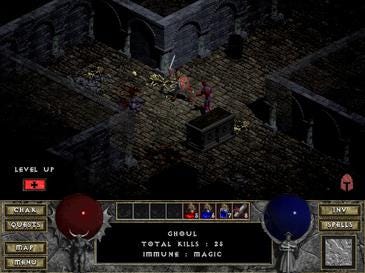
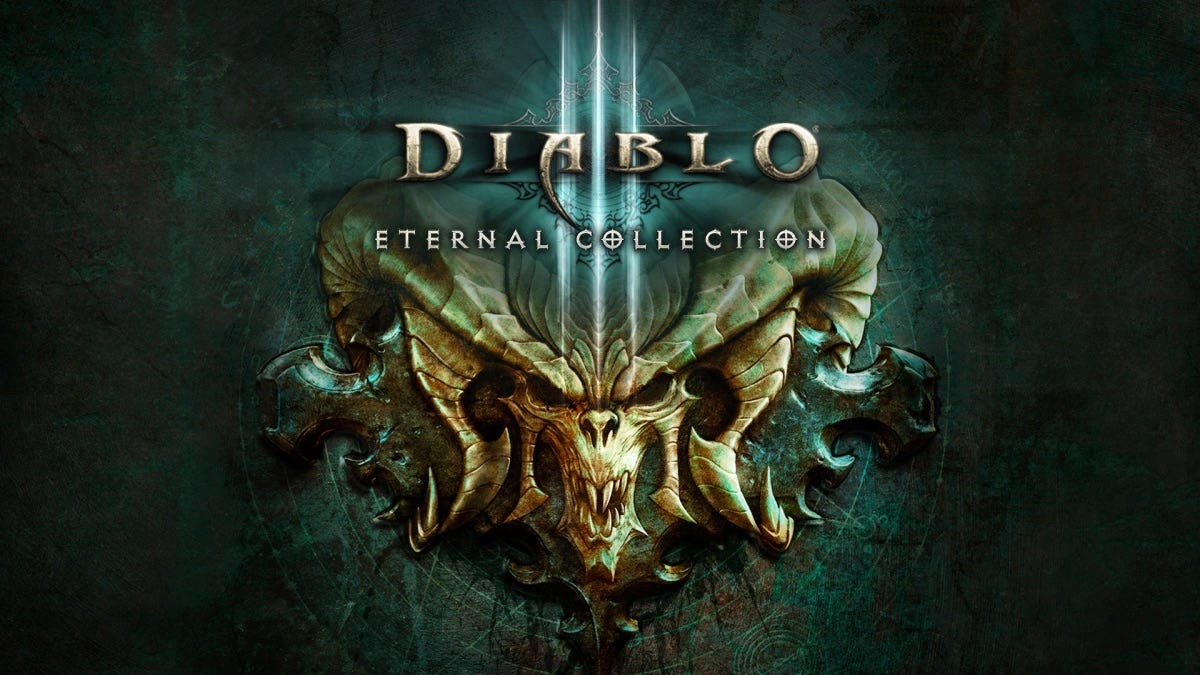
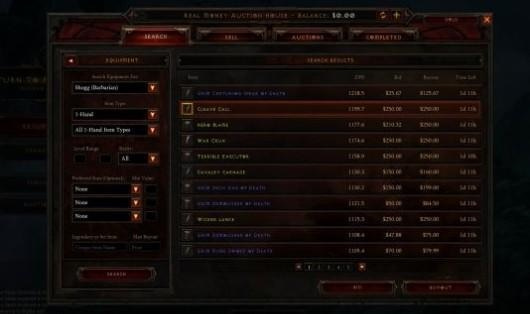
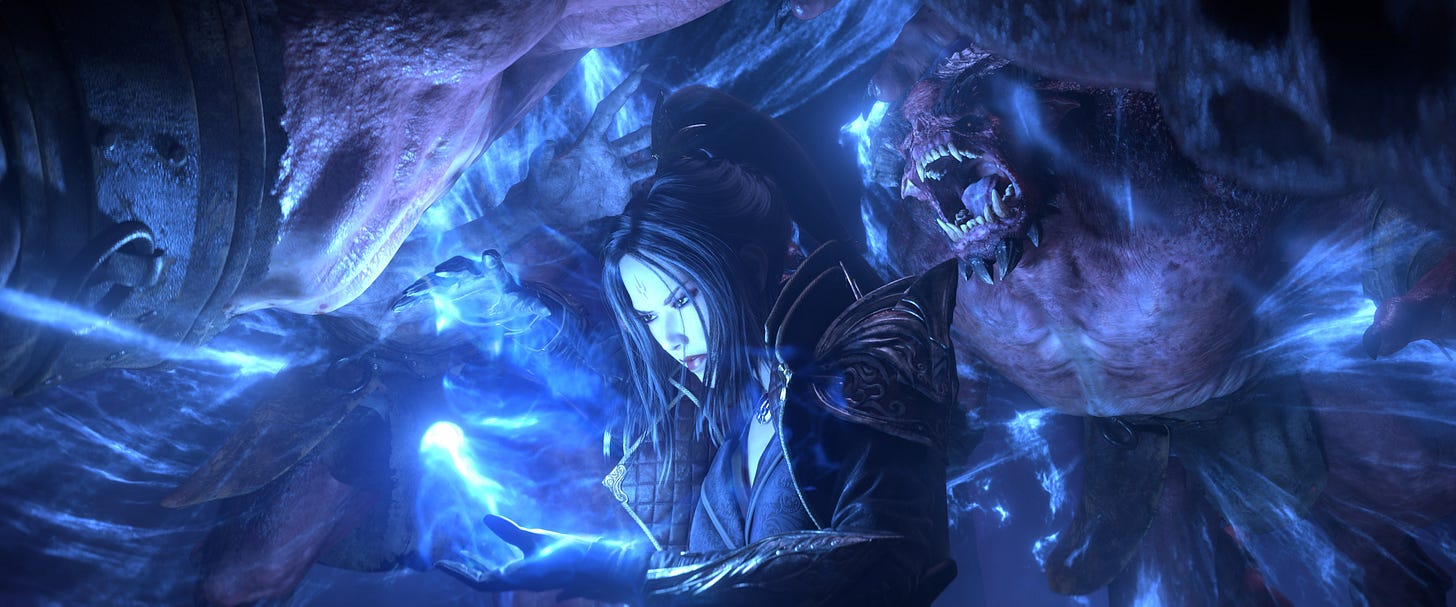
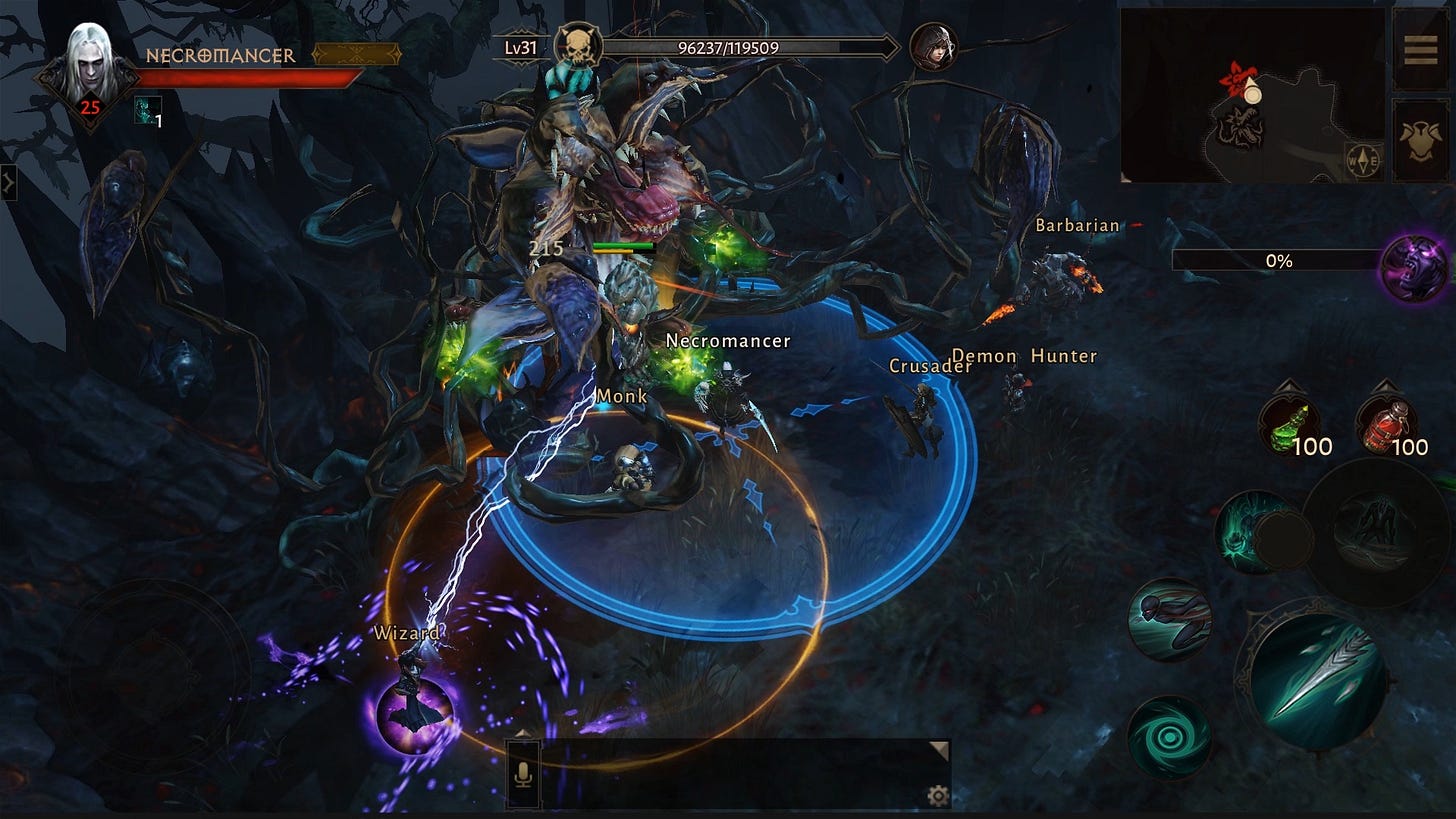
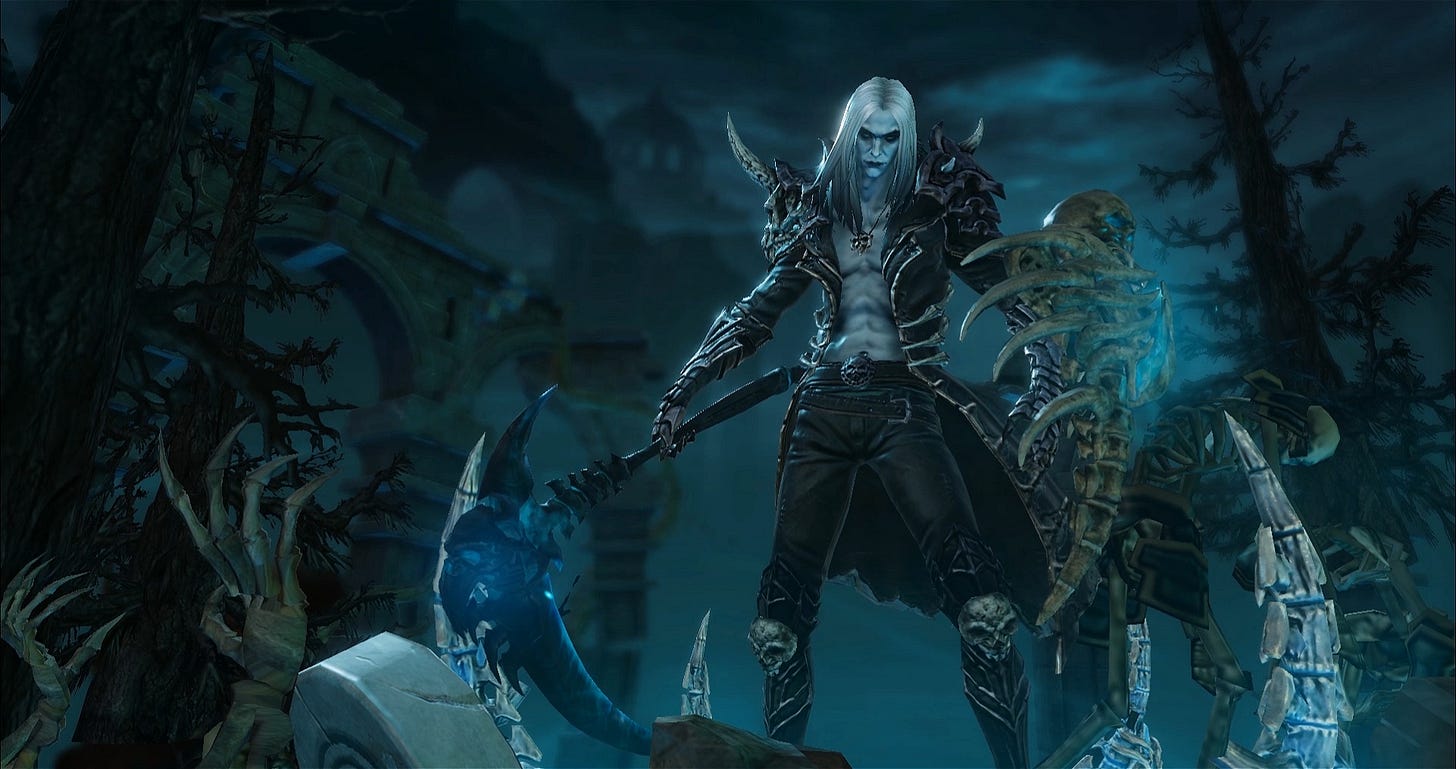
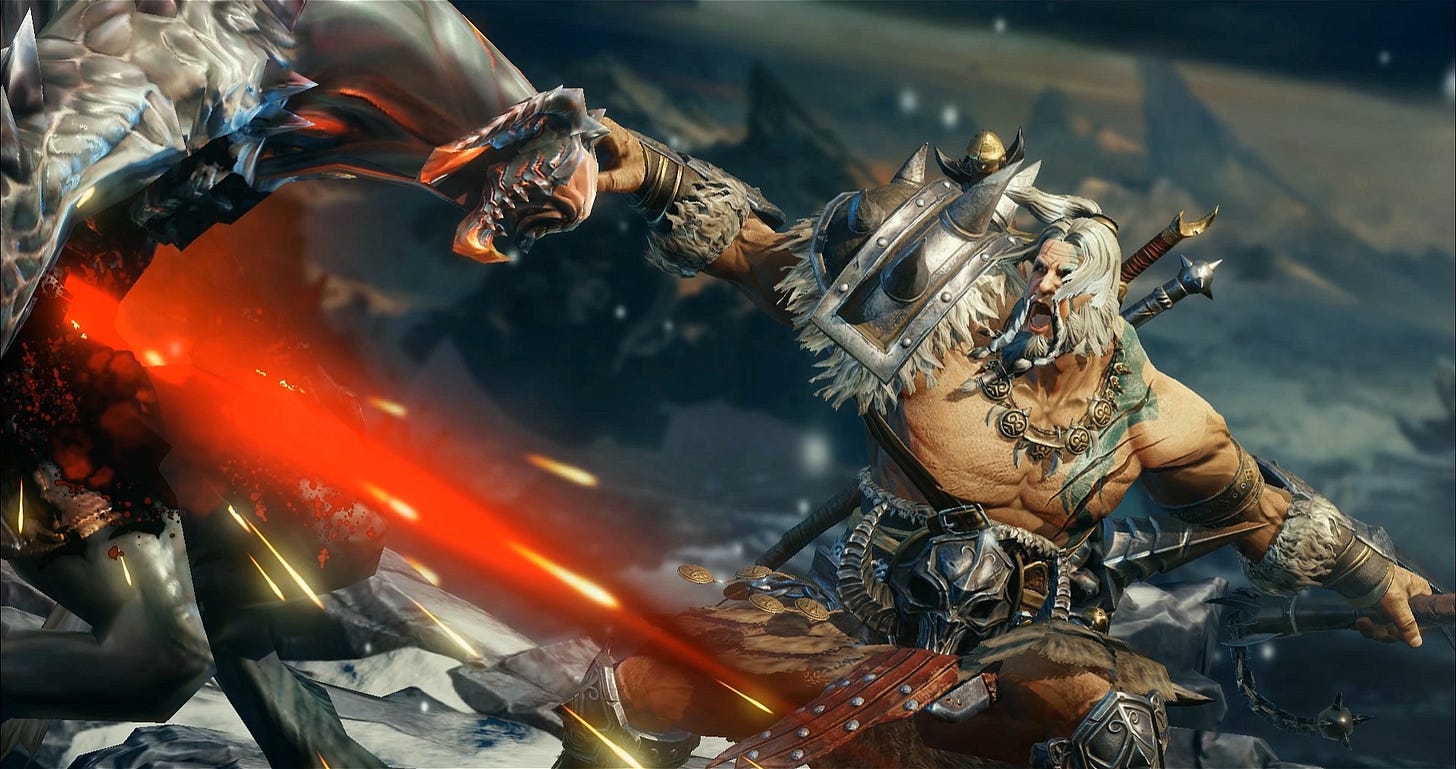

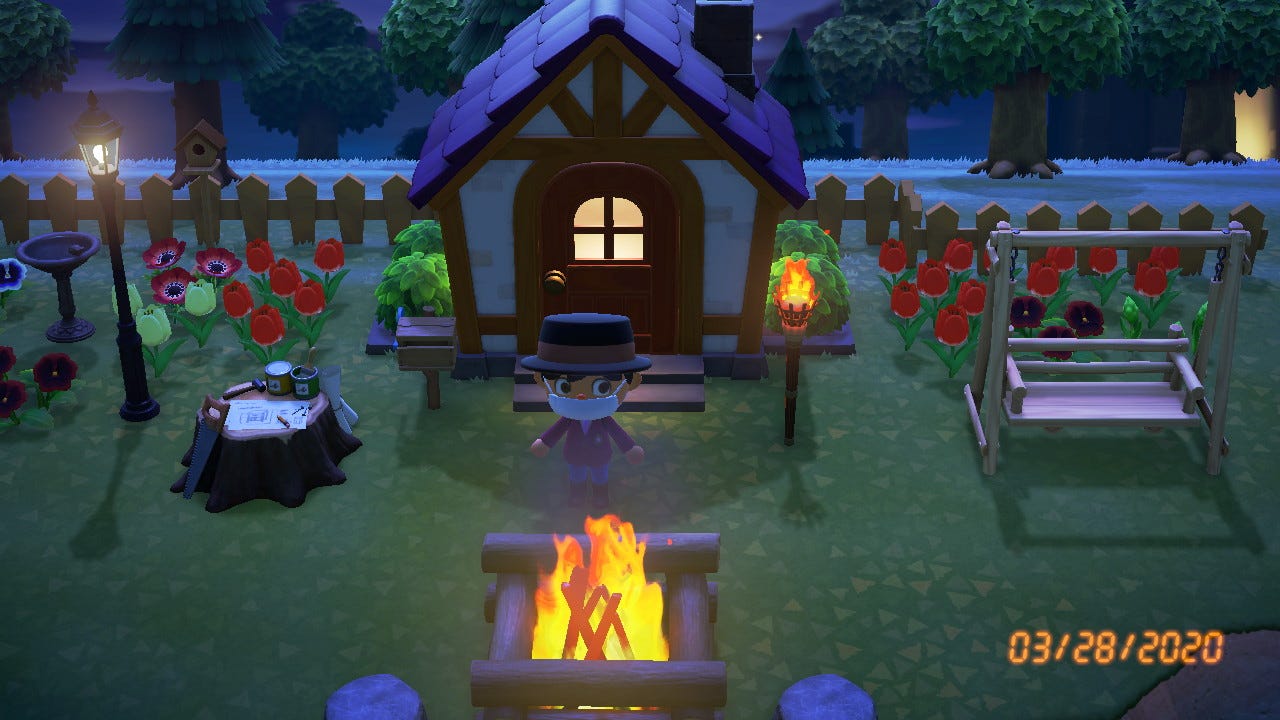
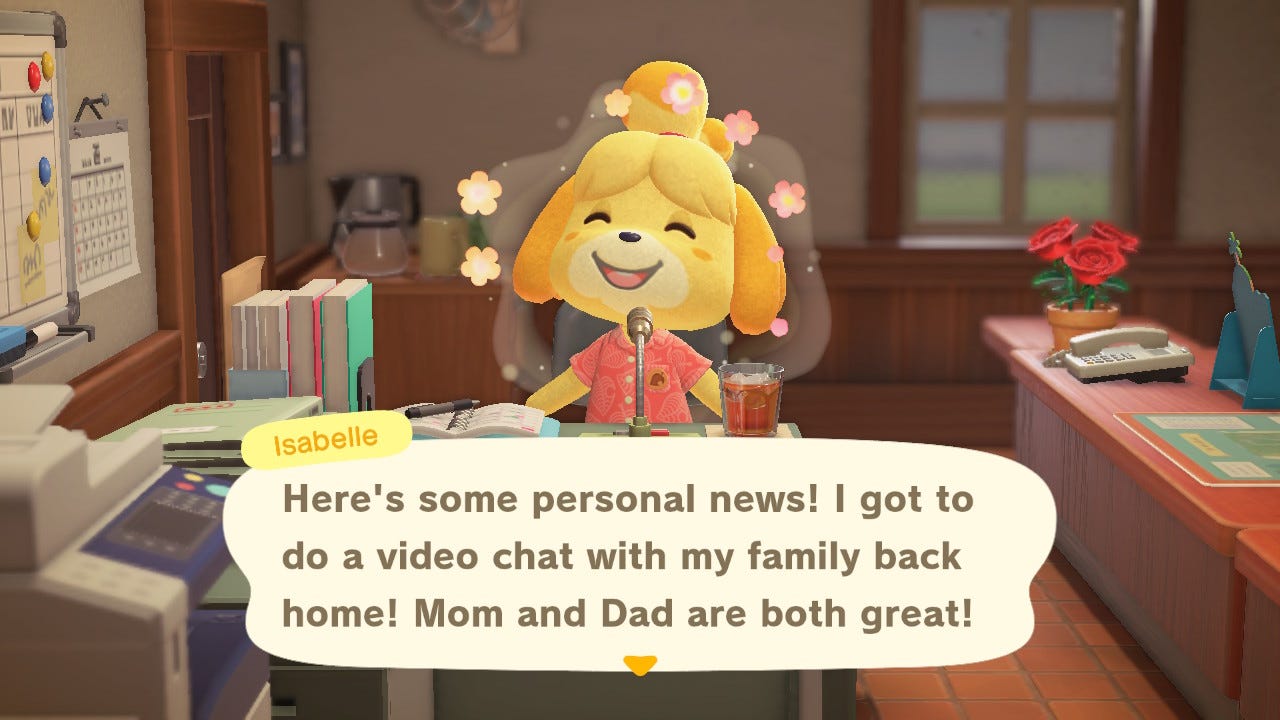
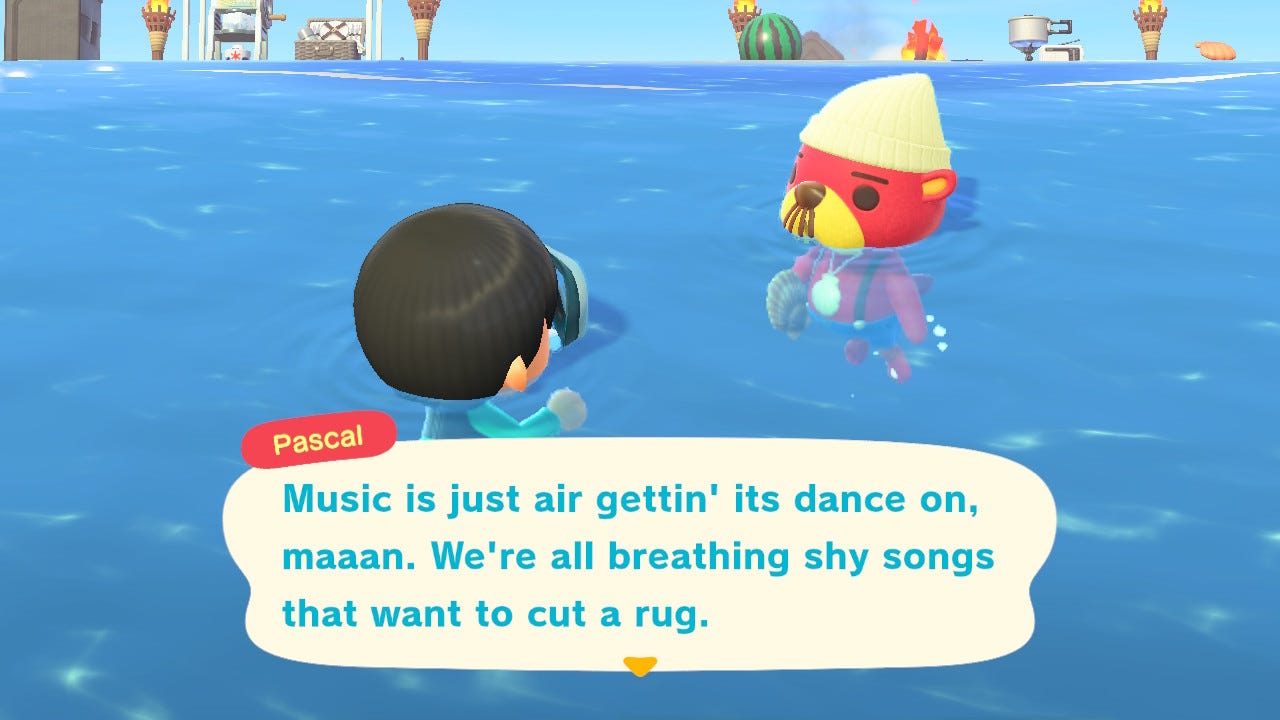
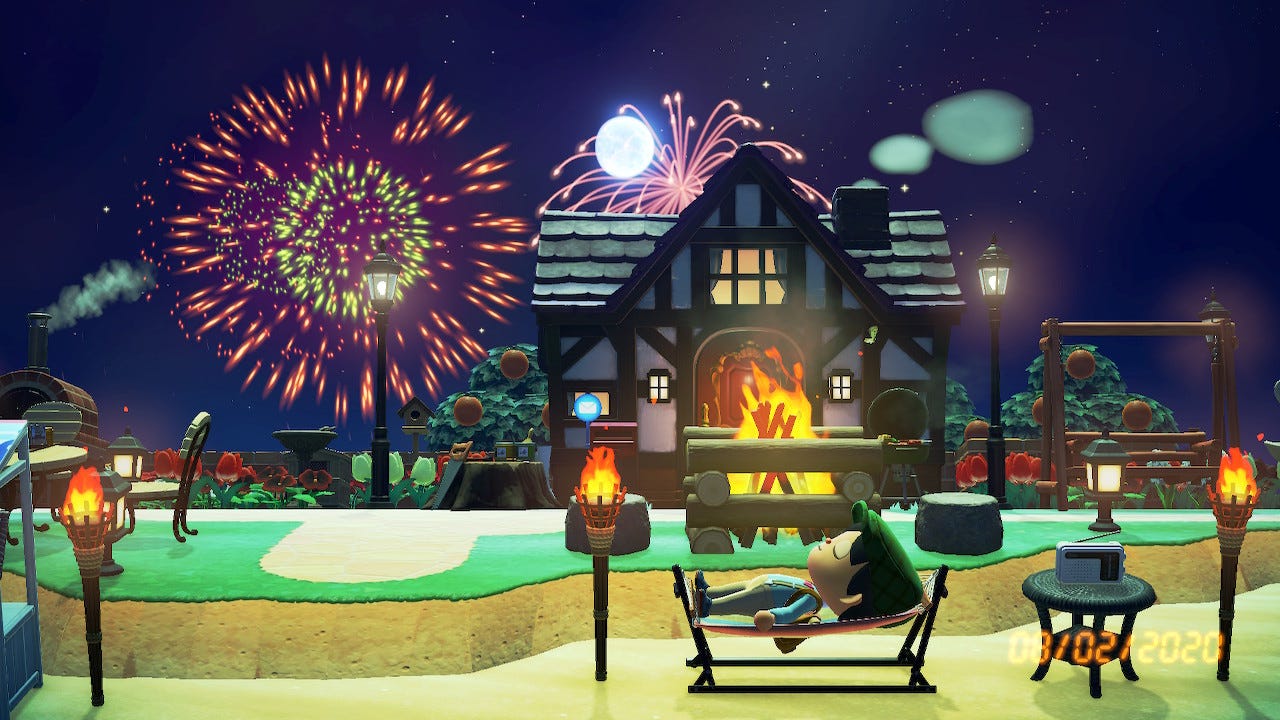

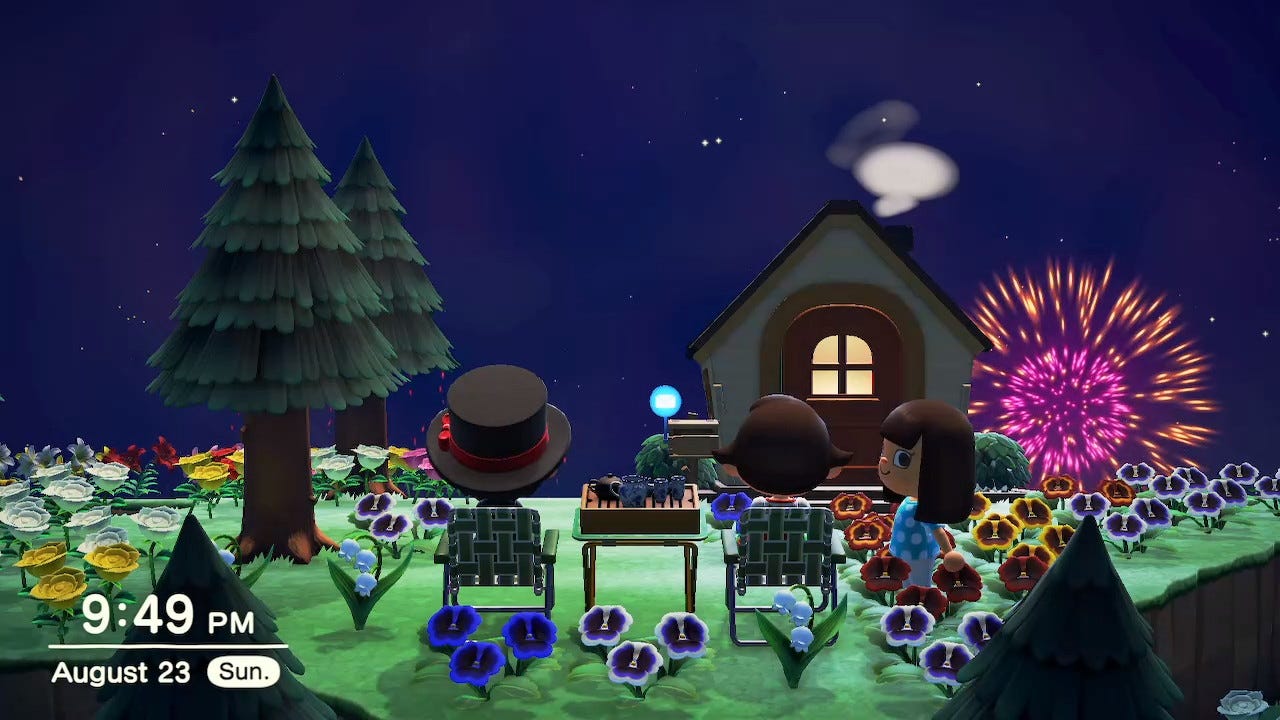
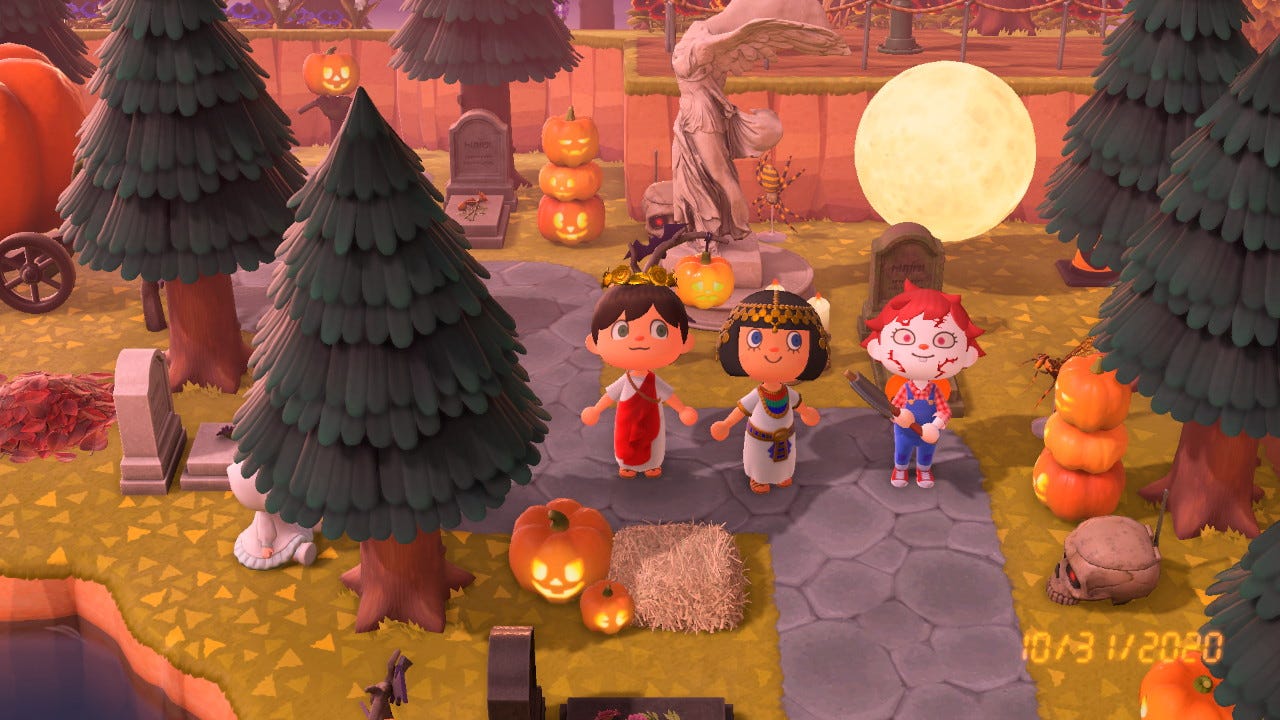
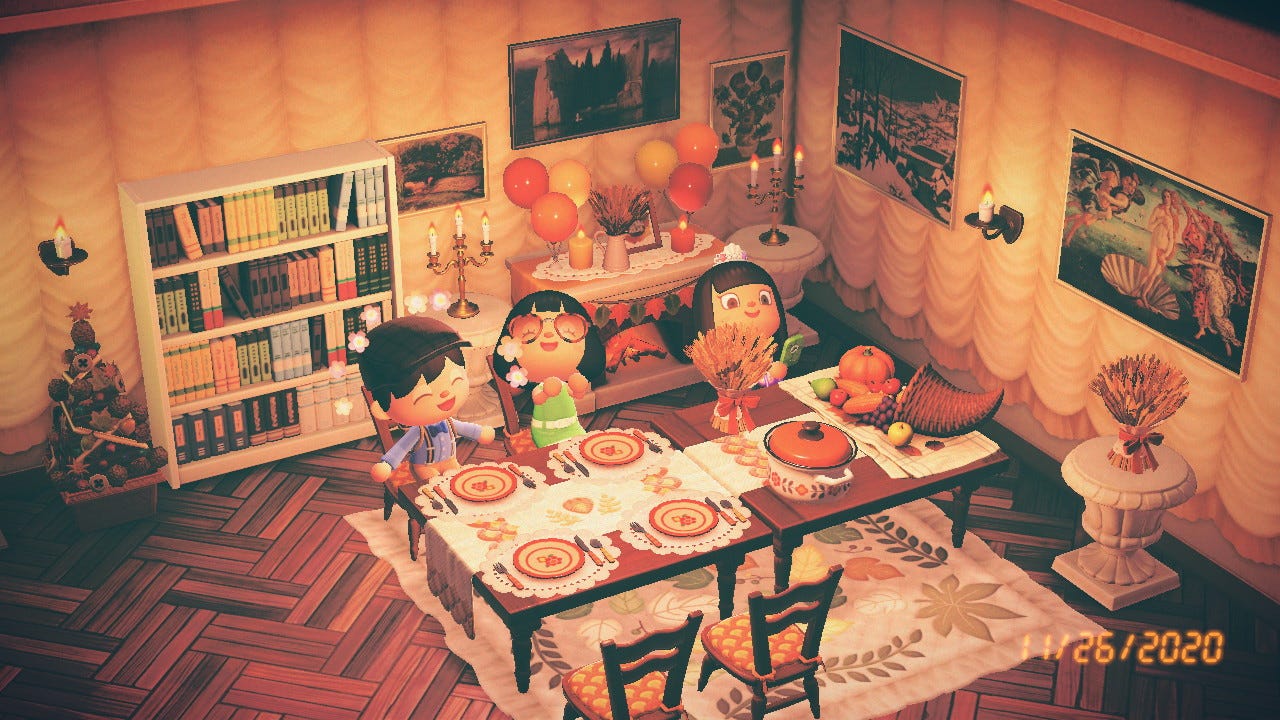
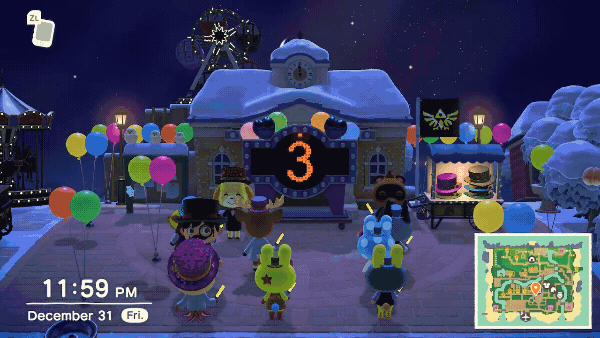
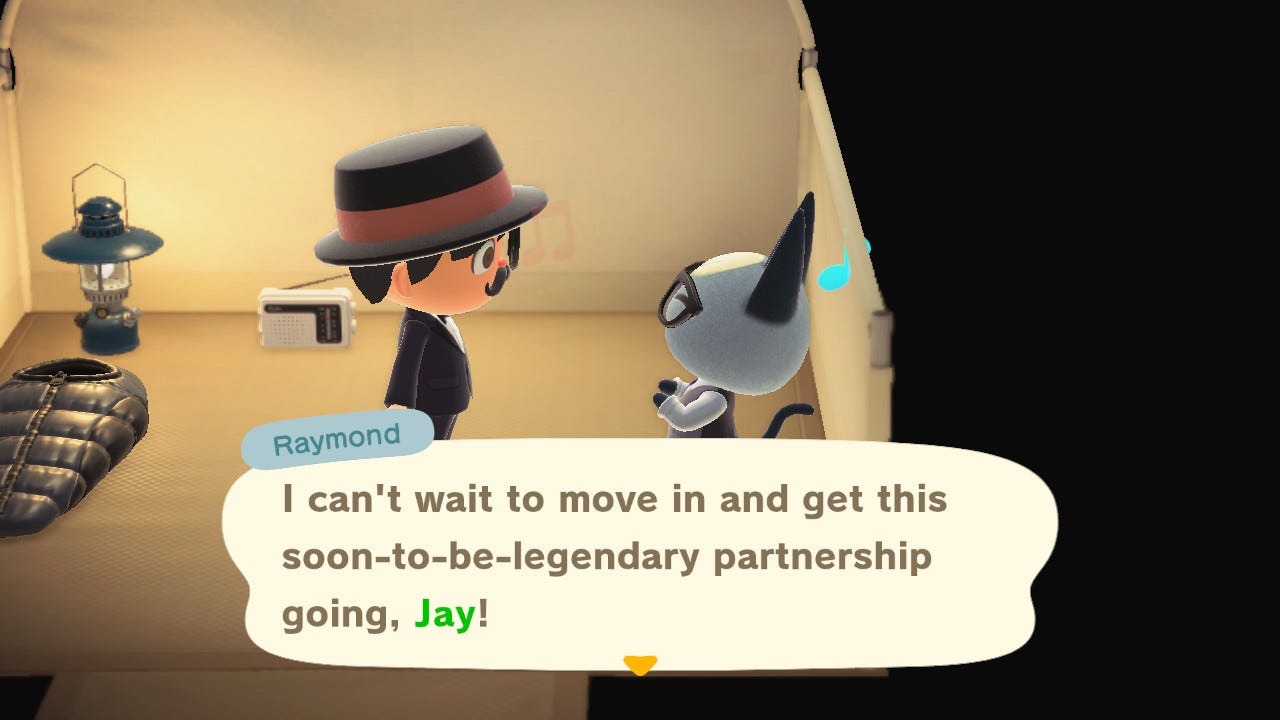
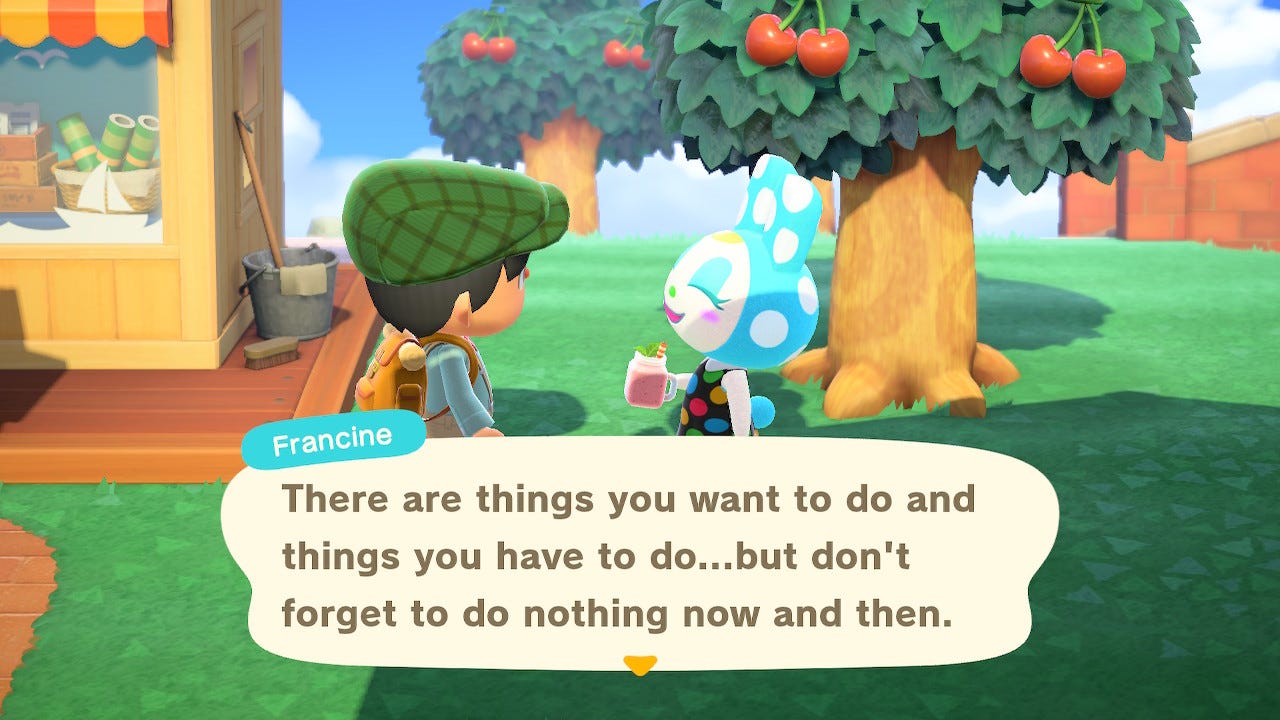

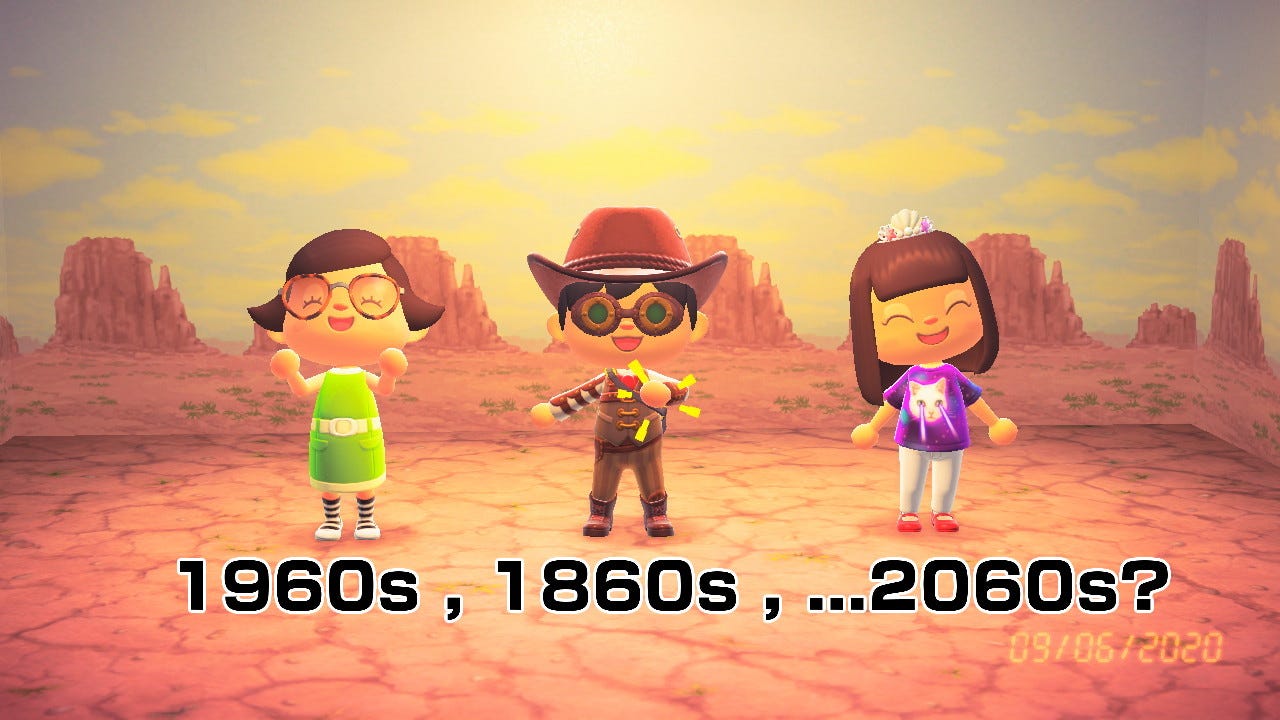

Thanks for this article! I've never played Animal Crossing before and have always wondered why it is so popular -- I have to say even as a non-gamer you made me want to get a Switch and play it! Lots of interesting food for thought here. I'm especially interested in the concept of real world time in the game -- I just recently read the book 4000 Weeks: Time Management for Mortals by Olivier Burkeman and he touches on research about how important it is for us to feel like our experiences our happening in sync with others; when they don't, they feel less meaningful and less psychologically "good" (for lack of a better word!). What you wrote about this in Animal Crossing definitely makes me think about this phenomenon...
Great write-up. I had no idea how predatory the latest Diablo game was/is. I agree we all need to be more outspoken against these trends if we wish to see the end of them, or to at least slow their pace. For my part, I tend to do more research on a game before pulling the trigger. If it seems to have an abundance of mtx (loot boxes or otherwise), I will typically pass on the game entirely, even if it's well reviewed. I've not regretted missing out on a game yet! I encourage others to adopt this strategy when shopping for games.